Search Result
Results for "
selective peripheral
" in MedChemExpress (MCE) Product Catalog:
16
Isotope-Labeled Compounds
| Cat. No. |
Product Name |
Target |
Research Areas |
Chemical Structure |
-
- HY-100798
-
|
|
GABA Receptor
|
Neurological Disease
|
|
Phaclofen is a selective GABAB receptor antagonist. Phaclofen is a peripheral and central baclofen antagonist. Phaclofen maybe a potential compound in determining the physiological significance of central and peripheral bicuculline-insensitive receptors with which GABA and (-)-baclofen interact .
|
-
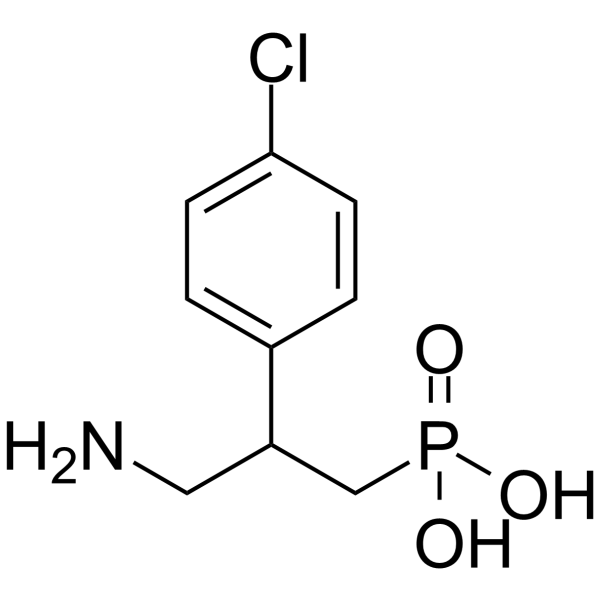
-
- HY-B0233
-
|
PN 200-110
|
Calcium Channel
Autophagy
|
Cardiovascular Disease
Neurological Disease
|
|
Isradipine (PN 200-110) is an orally active L-type calcium channel blocker. Isradipine, as a powerful peripheral vasodilator, is a dihydropyridine calcium antagonist with selective actions on the heart as well as the peripheral circulation. Isradipine is a potentially viable neuroprotective agent for Parkinson's disease .
|
-
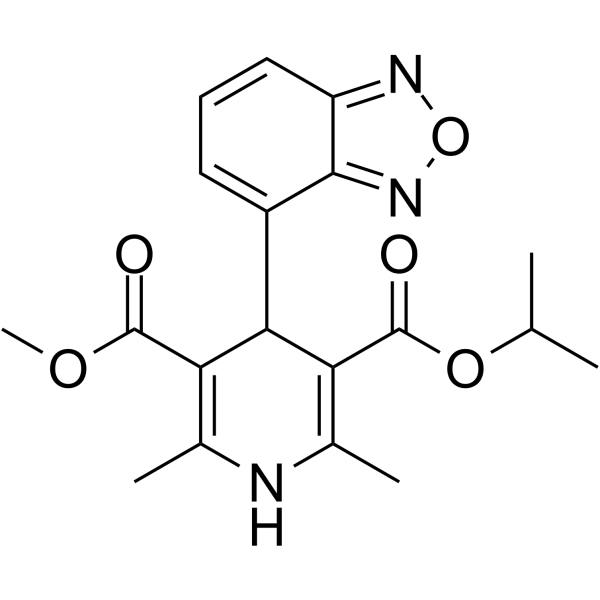
-
- HY-B0233S2
-
|
PN 200-110-d7
|
Calcium Channel
Autophagy
Isotope-Labeled Compounds
|
Cardiovascular Disease
Neurological Disease
|
|
Isradipine-d7 is deuterated labeled Isradipine (HY-B0233). Isradipine (PN 200-110) is an orally active L-type calcium channel blocker. Isradipine, as a powerful peripheral vasodilator, is a dihydropyridine calcium antagonist with selective actions on the heart as well as the peripheral circulation. Isradipine is a potentially viable neuroprotective agent for Parkinson's disease .
|
-
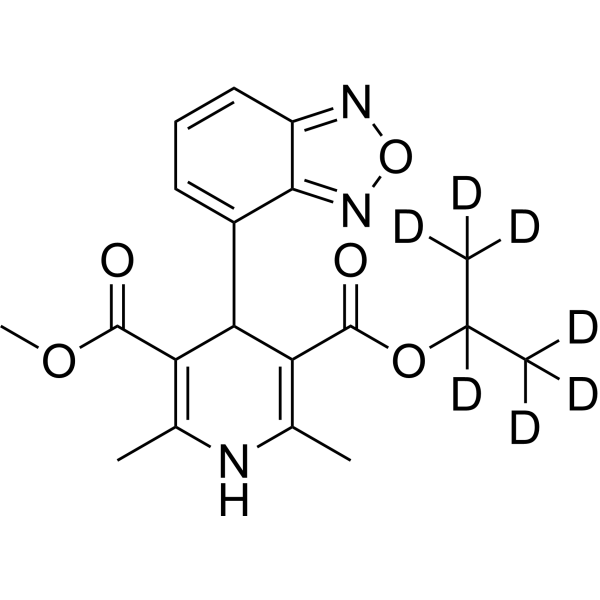
-
- HY-B0233R
-
|
|
|
Cardiovascular Disease
Neurological Disease
|
|
Isradipine (Standard) is the analytical standard of Isradipine. This product is intended for research and analytical applications. Isradipine (PN 200-110) is an orally active L-type calcium channel blocker. Isradipine, as a powerful peripheral vasodilator, is a dihydropyridine calcium antagonist with selective actions on the heart as well as the peripheral circulation. Isradipine is a potentially viable neuroprotective agent for Parkinson's disease .
|
-

-
- HY-145884
-
|
|
Btk
|
Inflammation/Immunology
|
|
BTK-IN-8 is a potent and selective peripheral covalent BTK inhibitor (IC50=0.22 nM; Kd=0.91 nM). BTK-IN-8 has good whole blood CD69 cellular potency (IC50=0.029 µM) .
|
-
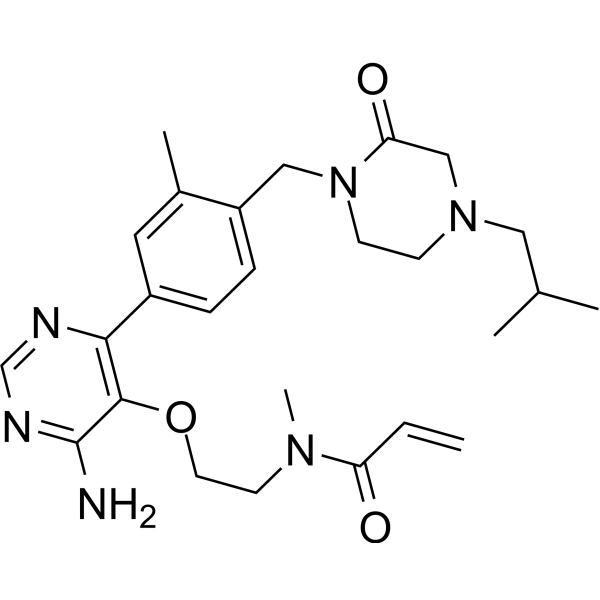
-
- HY-131879
-
|
|
Sodium Channel
|
Neurological Disease
|
|
NS383 is a potent and uniquely selective inhibitor of rat ASICs containing 1a and/or 3 subunits. NS383 inhibits H(+)-activated currents recorded from rat homomeric ASIC1a, ASIC3, and heteromeric ASIC1a+3 with IC50 values ranging from 0.61 to 2.2 μM. NS383 is well tolerated and capable of reversing pathological painlike behaviors, presumably via peripheral actions, but possibly also via actions within central pain circuits .
|
-
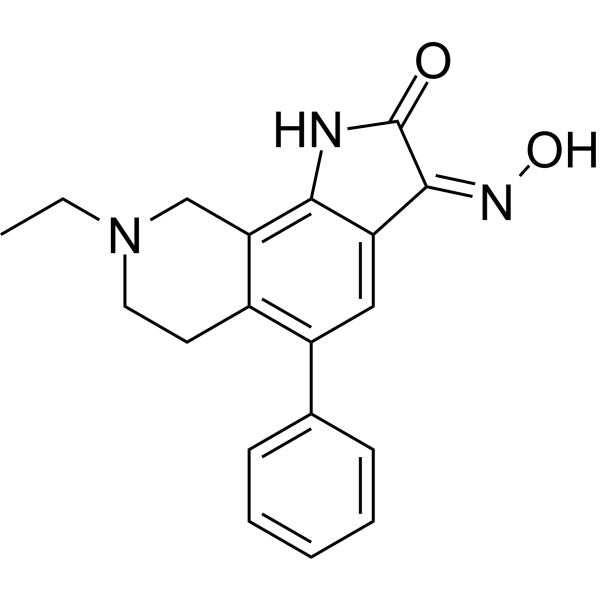
-
- HY-19945
-
|
|
GABA Receptor
|
Neurological Disease
|
|
DAA1106 is a potent and selective ligand for peripheral benzodiazepine receptor (PBR), as a potent and selective agonist at the peripheral benzodiazepine receptor.
|
-
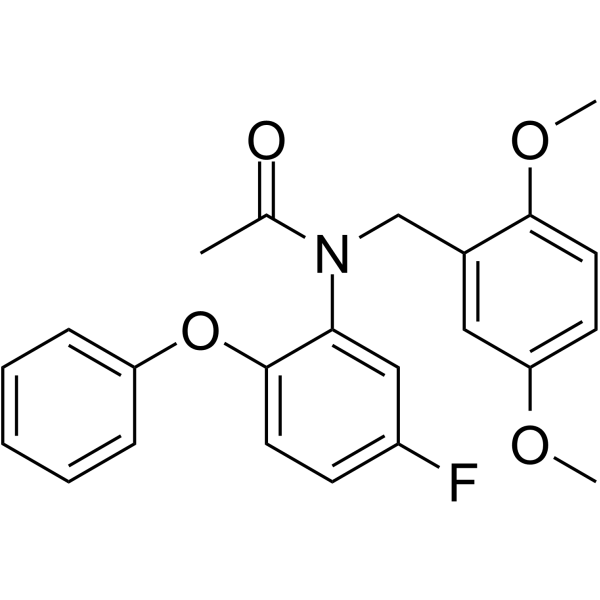
-
- HY-107319
-
-
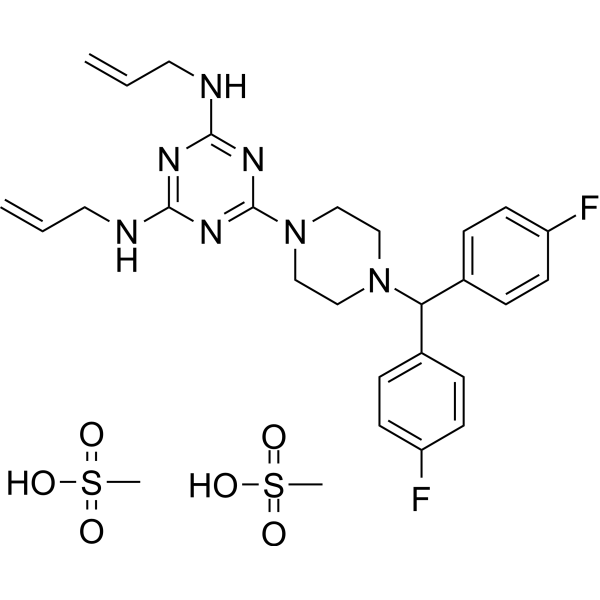
-
- HY-19721
-
-

-
- HY-101616
-
-
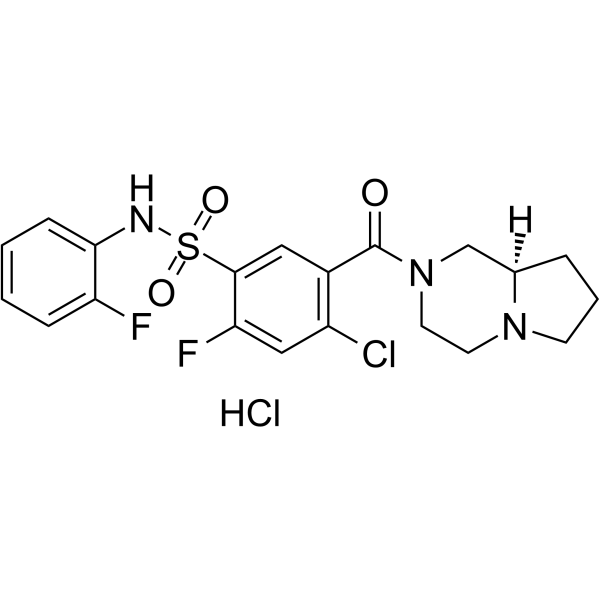
-
- HY-122616
-
-
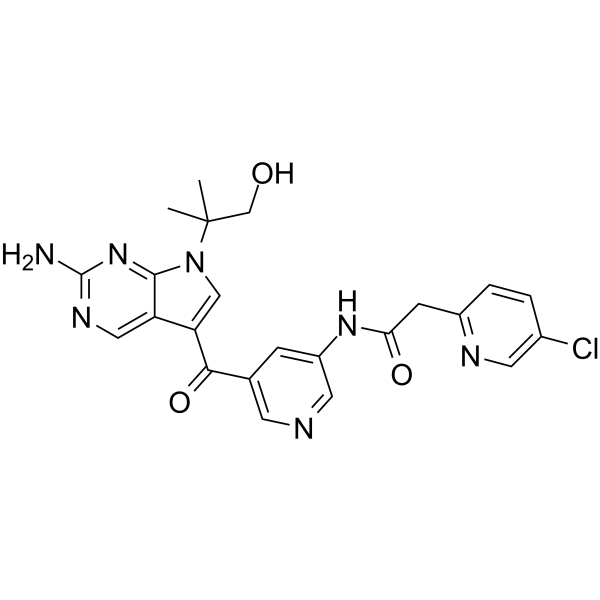
-
- HY-P3609
-
|
JNJ 38488502; FE 200665
|
Opioid Receptor
|
Neurological Disease
|
|
CR 665 (JNJ 38488502) is a peripherally selective κ-opioid agonist. CR 665 can activate the kappa opioid receptor with EC50 value of 10.9 nM. CR 665 can be used for the research of peripheral pain .
|
-
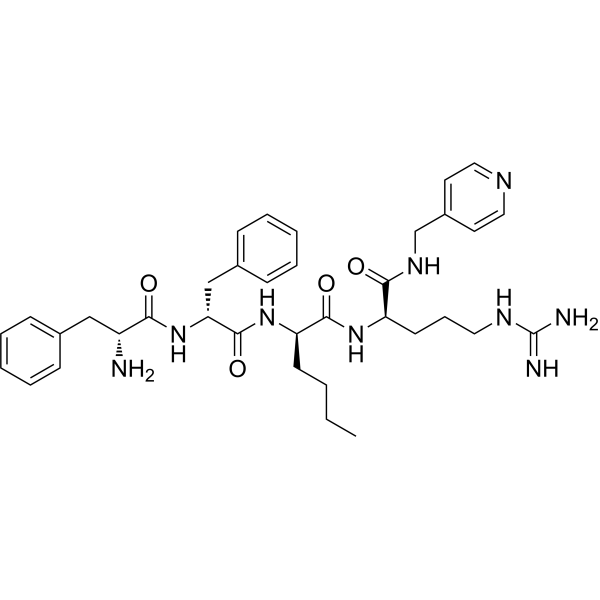
-
- HY-103410
-
|
EMD 45609 hydrochloride
|
Dopamine Receptor
|
Cardiovascular Disease
|
|
Carmoxirole hydrochloride (EMD 45609 hydrochloride) is a selective, peripherally acting dopamine D2 receptor agonist and exhibits antihypertensive activities in vivo .
|
-
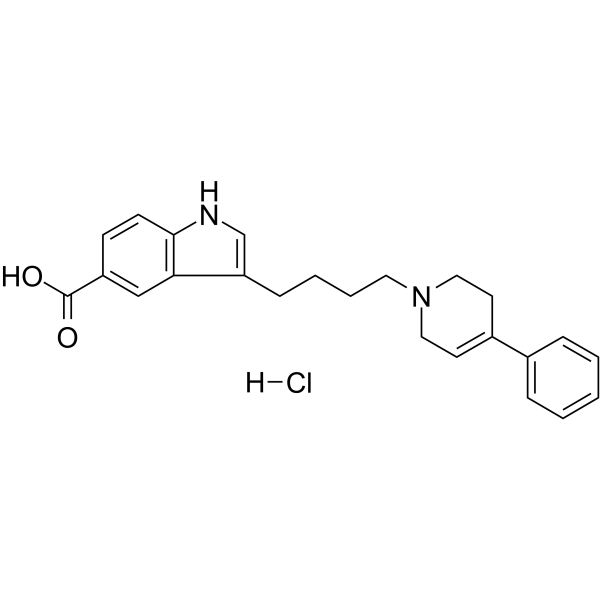
-
- HY-155089
-
|
|
MAP3K
|
Neurological Disease
|
|
IACS-52825 is a potent and selective DLK inhibitor with Kd of 1.3 nM, useful for the study of chemotherapy-induced peripheral neuropathy .
|
-
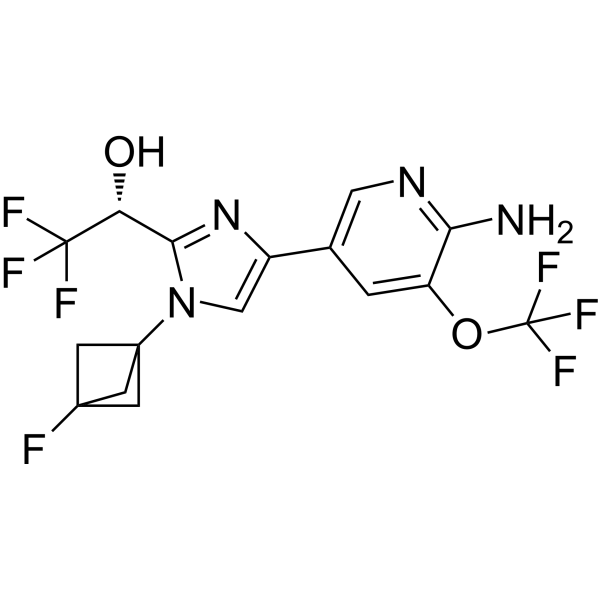
-
- HY-119605
-
|
|
Others
|
Neurological Disease
|
|
DAA-1097 is an orally active and selective agonist for the peripheral benzodiazepine receptor (PBR). DAA-1097 has anxiolytic effects .
|
-

-
- HY-13331
-
|
Cortexolone 17 alpha-propionate; Cortexolone 17α-propionate; CB-03-01
|
Androgen Receptor
|
Endocrinology
|
|
Clascoterone (Cortexolone 17 alpha-propionate;Cortexolone 17α-propionate;CB-03-01) is a new topical and peripherally selective androgen antagonist.
|
-
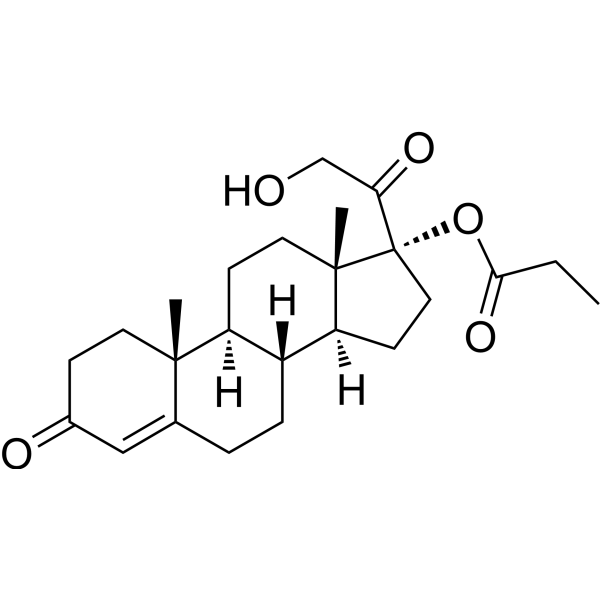
-
- HY-103210
-
|
Neurotoxin DSP 4 hydrochloride
|
Others
|
Neurological Disease
|
|
DSP-4 hydrochloride is a highly and selective adrenergic neurotoxin. DSP-4 hydrochloride can cross the blood brain barrier. DSP-4 hydrochloride can be used for the temporary selective degradation of the central and peripheral noradrenergic neurons .
|
-
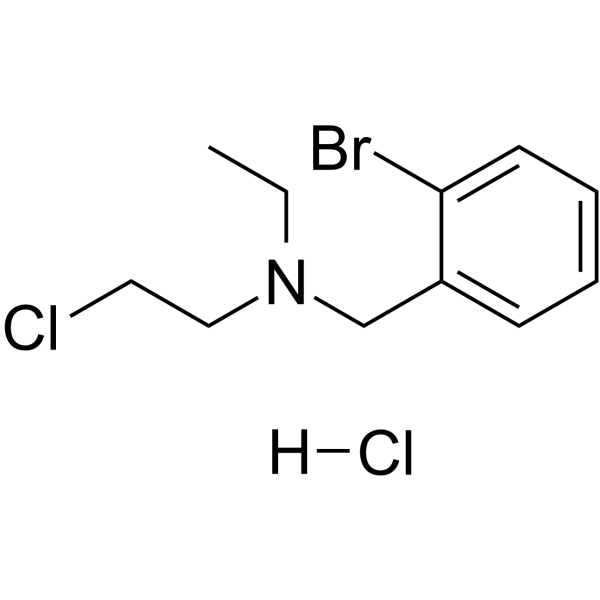
-
- HY-B0233S1
-
|
PN 200-110-d6
|
Calcium Channel
Autophagy
|
|
|
Isradipine-d6 is the deuterium labeled Isradipine[1]. Isradipine (PN 200-110) is an orally active L-type calcium channel blocker. Isradipine, as a powerful peripheral vasodilator, is a dihydropyridine calcium antagonist with selective actions on the heart as well as the peripheral circulation. Isradipine is a potentially viable neuroprotective agent for Parkinson's disease[2][3][4].
|
-

-
- HY-121599
-
|
SGS-742
|
GABA Receptor
|
Neurological Disease
|
|
CGP 36742 is a selective GABAB receptor antagonist that can penetrate the blood–brain barrier after peripheral administration, with an IC50 of 32 μM. CGP 36742 is useful in treatment of depression .
|
-
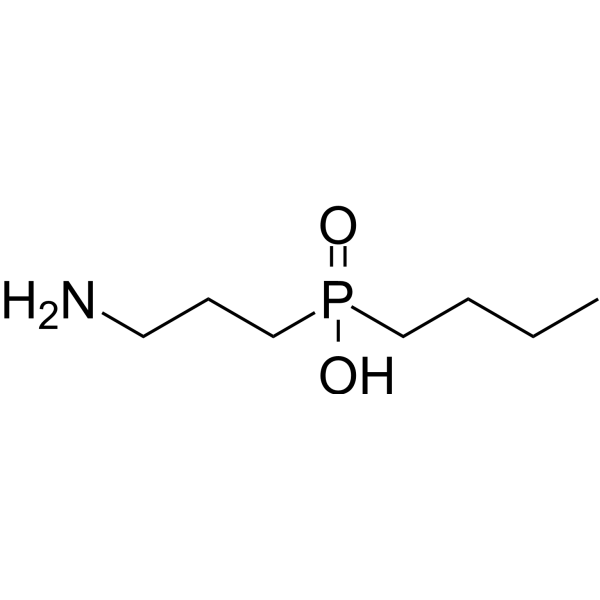
-
- HY-101381
-
|
AF-DX 116
|
mAChR
|
Neurological Disease
Metabolic Disease
|
|
Otenzepad (AF-DX 116) is a selective and competitive M2 muscarinic acetylcholine receptor antagonist, with IC50 values of 640 nM and 386 nM for rabbit peripheral lung and rat heart, respectively .
|
-

-
- HY-106147
-
|
|
Opioid Receptor
|
Neurological Disease
|
|
Frakefamide is a potent analgesic that acts as a peripheral active μ-selective receptor agonist. Frakefamide is unable to penetrate the blood-brain-barrier and enter the central nervous system .
|
-
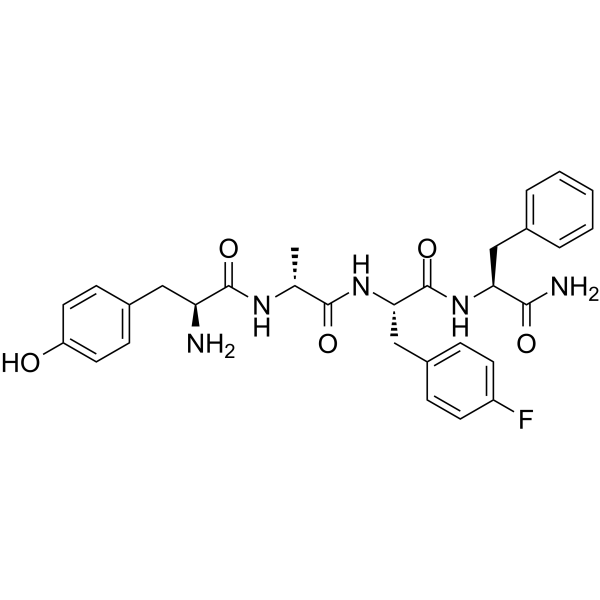
-
- HY-106147B
-
|
|
Opioid Receptor
|
Neurological Disease
|
|
Frakefamide TFA is a potent analgesic that acts as a peripheral active μ-selective receptor agonist. Frakefamide is unable to penetrate the blood-brain-barrier and enter the central nervous system .
|
-
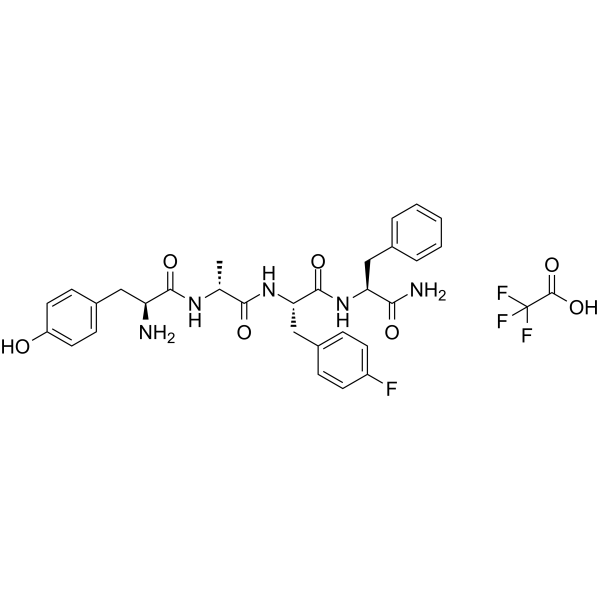
-
- HY-129787
-
|
|
Cannabinoid Receptor
|
Neurological Disease
|
|
PF-03550096 is an orally active synthetic cannabinoid (CB) that selectively targets peripheral CB2 receptors with a Ki value of 7.9 nM. PF-03550096 has analgesic activity .
|
-
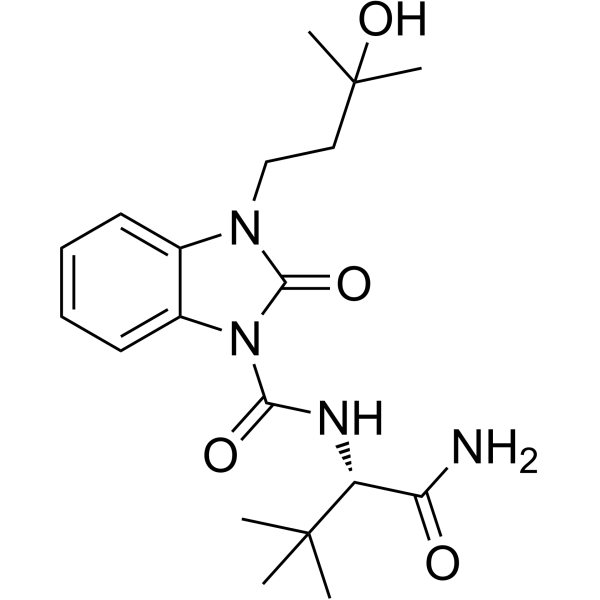
-
- HY-B0233S
-
|
|
Calcium Channel
Autophagy
|
Cardiovascular Disease
Neurological Disease
|
|
Isradipine-d3 (PN 200-110-d3) is the deuterium labeled Isradipine. Isradipine (PN 200-110) is an orally active L-type calcium channel blocker. Isradipine, as a powerful peripheral vasodilator, is a dihydropyridine calcium antagonist with selective actions on the heart as well as the peripheral circulation. Isradipine is a potentially viable neuroprotective agent for Parkinson's disease[1][2][3].
|
-
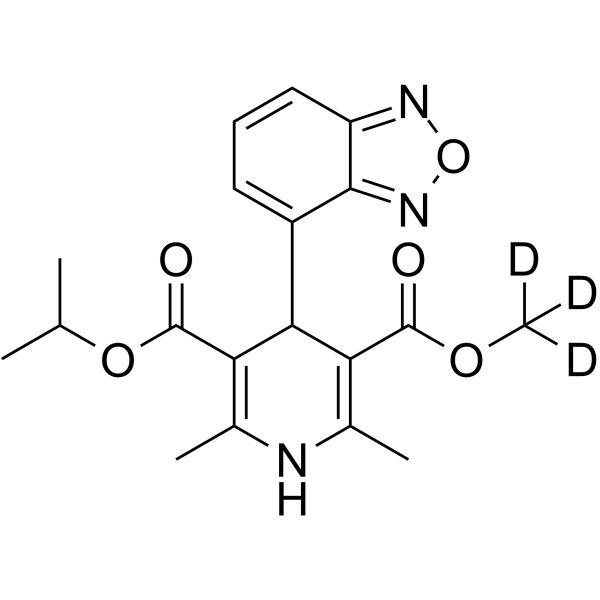
-
- HY-108229
-
|
6β-Hydroxynaltrexone
|
Drug Metabolite
Opioid Receptor
|
Neurological Disease
|
|
6β-Naltrexol (6β-Hydroxynaltrexone), the primary metabolite of Naltrexone, is a peripherally selective opioid antagonist. 6β-Naltrexol selectively inhibits gastrointestinal opioid effects in human subjects and inhibits Morphine-induced slowing of gastrointestinal transit .
|
-
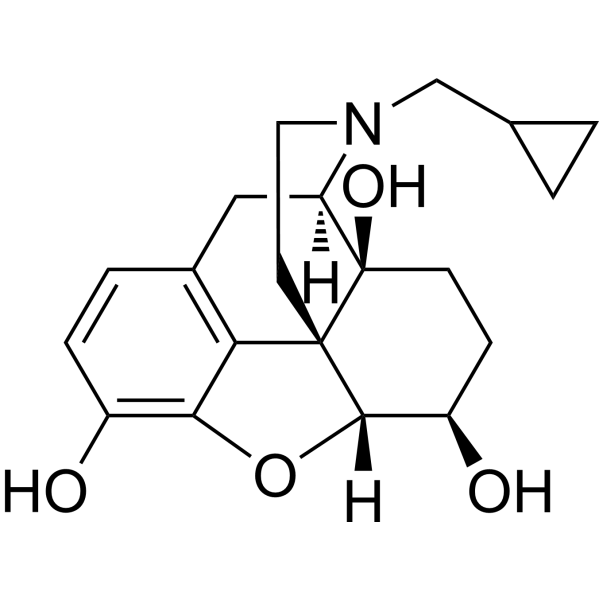
-
- HY-107384
-
|
EMD-61753
|
Opioid Receptor
|
Neurological Disease
Metabolic Disease
Inflammation/Immunology
|
|
Asimadoline (EMD-61753) is an orally active, selective and peripherally active κ-opioid agonist with IC50s of 5.6 nM (guinea pig) and 1.2 nM (human recombinant). Asimadoline has low permeability across the blood brain barrier and has peripheral anti-inflammatory actions. Asimadoline ameliorates allodynia in diabetic rats and has the potential for irritable bowel syndrome (IBS) .
|
-
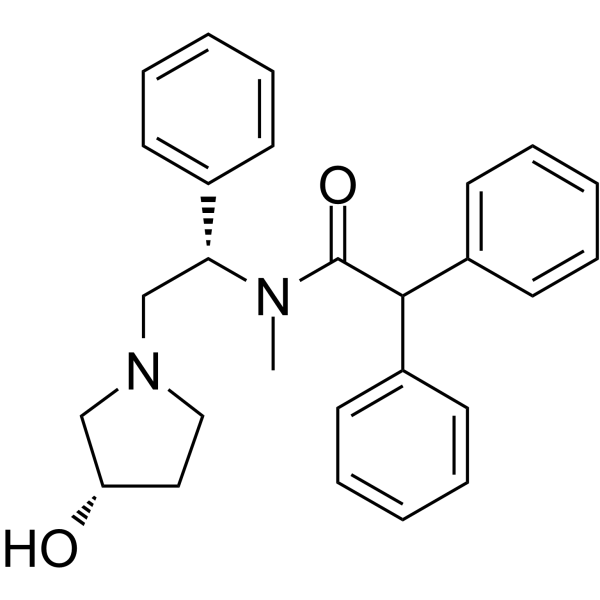
-
- HY-107384A
-
|
EMD-61753 hydrochloride
|
Opioid Receptor
|
Neurological Disease
Metabolic Disease
Inflammation/Immunology
|
|
Asimadoline (EMD-61753) hydrochloride is an orally active, selective and peripherally active κ-opioid agonist with IC50s of 5.6 nM (guinea pig) and 1.2 nM (human recombinant). Asimadoline hydrochloride has low permeability across the blood brain barrier and has peripheral anti-inflammatory actions. Asimadoline hydrochloride ameliorates allodynia in diabetic rats and has the potential for irritable bowel syndrome (IBS) .
|
-
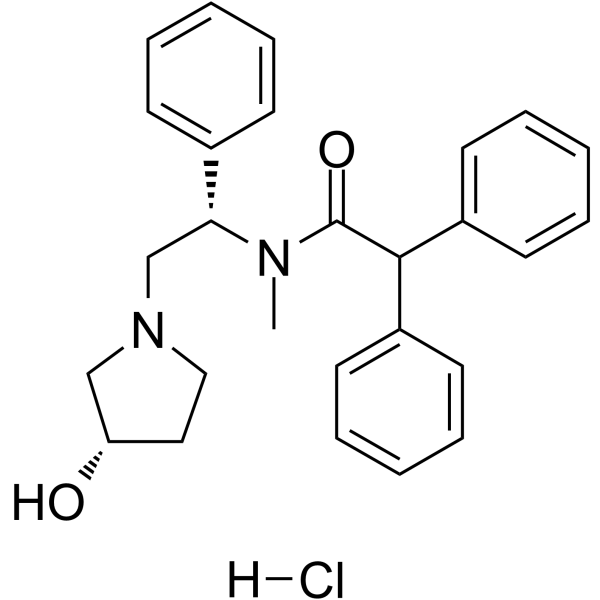
-
- HY-111791
-
|
|
HDAC
|
Cancer
|
|
ACY-1083 is a selective and brain-penetrating HDAC6 inhibitor with an IC50 of 3 nM and is 260-fold more selective for HDAC6 than all other classes of HDAC isoforms. ACY-1083 effectively reverses chemotherapy-induced peripheral neuropathy .
|
-
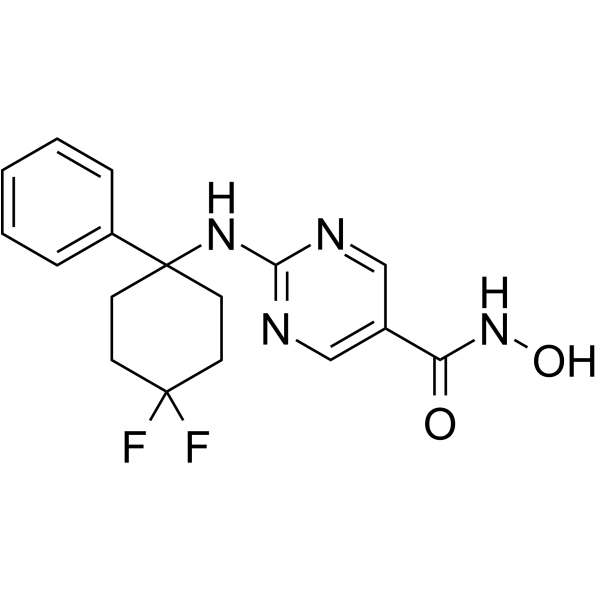
-
- HY-B0311
-
|
(S)-(-)-Carbidopa
|
Aryl Hydrocarbon Receptor
|
Neurological Disease
Cancer
|
|
Carbidopa ((S)-(-)-Carbidopa), a peripheral decarboxylase inhibitor, can be used for the research of Parkinson's disease. Carbidopa is a selective aryl hydrocarbon receptor (AhR) modulator. Carbidopa inhibits pancreatic cancer cell and tumor growth .
|
-

-
- HY-B0311A
-
|
(S)-(-)-Carbidopa monohydrate
|
Aryl Hydrocarbon Receptor
|
Neurological Disease
Cancer
|
|
Carbidopa ((S)-(-)-Carbidopa) monohydrate, a peripheral decarboxylase inhibitor, can be used for the research of Parkinson's disease. Carbidopa monohydrate is a selective aryl hydrocarbon receptor (AhR) modulator. Carbidopa monohydrate inhibits pancreatic cancer cell and tumor growth .
|
-
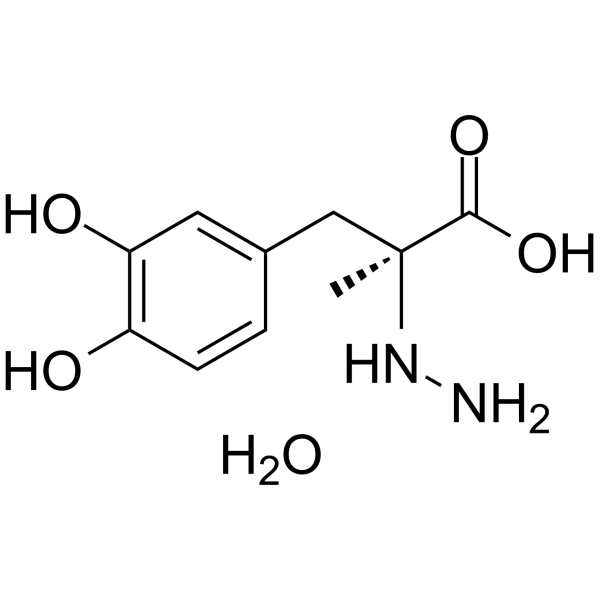
-
- HY-B0347
-
|
|
Calcium Channel
Reactive Oxygen Species
Caspase
Apoptosis
|
Cardiovascular Disease
|
|
Lacidipine is an orally active and highly selective L-type calcium channel blocker that acts on smooth muscle calcium channels, primarily dilates peripheral arteries, reduces peripheral resistance, and has long-lasting anti-hypertensive activity. Lacidipine protects HKCs from apoptosis induced by ATP depletion and recovery by modulating the caspase-3 pathway. Lacidipine can be used in studies of hypertension, atherosclerosis and acute kidney injury (AKI) .
|
-

-
- HY-128038
-
|
|
Opioid Receptor
|
Neurological Disease
|
|
N-Desmethyl-loperamide is a major metabolite of loperamide, a drug that selectively activates peripheral μopioid receptors with a Ki value of 0.16 nM. N-Desmethyl-loperamide is a substrate of the ATP-dependent efflux transporter P-glycoprotein .
|
-
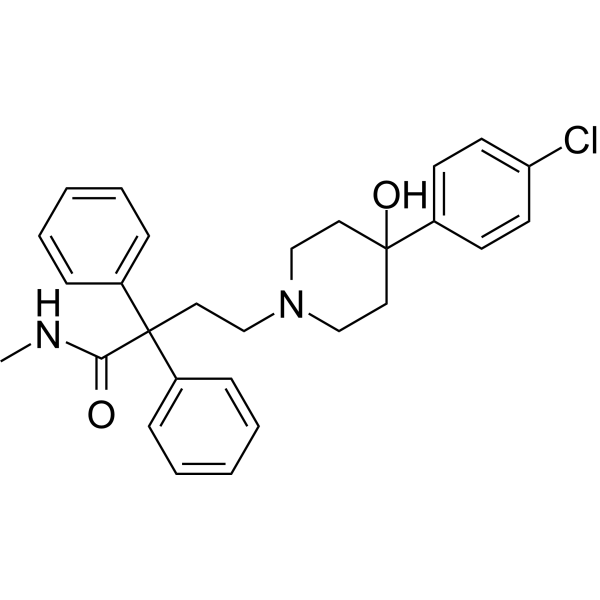
-
- HY-125881
-
|
|
LPL Receptor
|
Inflammation/Immunology
|
|
ASP1126 is a selective and orally active sphingosine-1-phosphate (S1P) agonist, with EC50 values of 7.12 nM, 517 nM for hS1P1 and hS1P3, respectively. ASP1126 decreases the number of peripheral lymphocytes, naive T cells, central memory T cells and effector memory T cells in the peripheral blood. ASP1126 has the potential to be applied in clinical transplantation with improved safety profile .
|
-
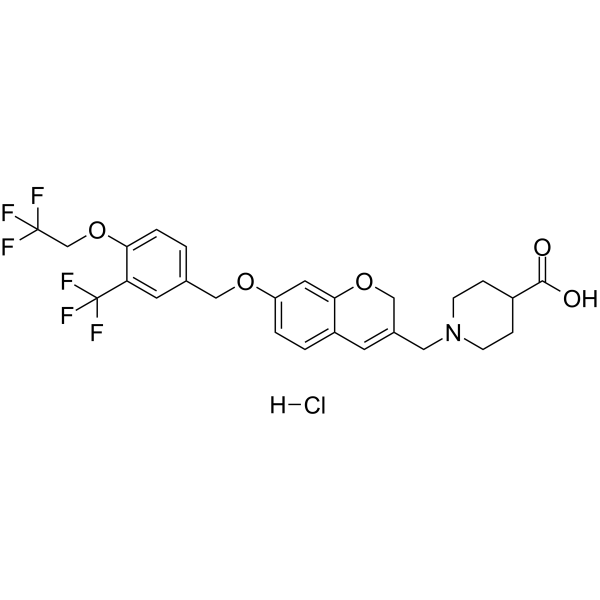
-
- HY-17609
-
|
CR-845; FE-202845
|
Opioid Receptor
|
Neurological Disease
|
|
Difelikefalin (CR-845; FE-202845) is a peripherally restricted and selective agonist of kappa opioid receptor (KOR). Difelikefalin produces anti-inflammatory effects and has the potential in modulating pruritus in conditions such as chronic kidney disease .
|
-

-
- HY-P5907
-
|
|
Opioid Receptor
|
Neurological Disease
|
|
Helianorphin-19 is a potent and selective κ-opioid receptor (KOR) activator with a Ki of 21 nM and an EC50 of 45 nM. Helianorphin-19 exhibits strong KOR-specific peripheral analgesic activity in a mouse model of chronic visceral pain .
|
-

-
- HY-17043
-
-

-
- HY-116018
-
|
|
Phospholipase
|
Neurological Disease
Inflammation/Immunology
Cancer
|
|
FKGK11 is a potent and selective inhibitor of GVIA iPLA2 (Group VIA calcium-independent phospholipase A2). FKGK11 can be used for the research of ovarian cancer and neurological disorders such as peripheral nerve injury and multiple sclerosis .
|
-
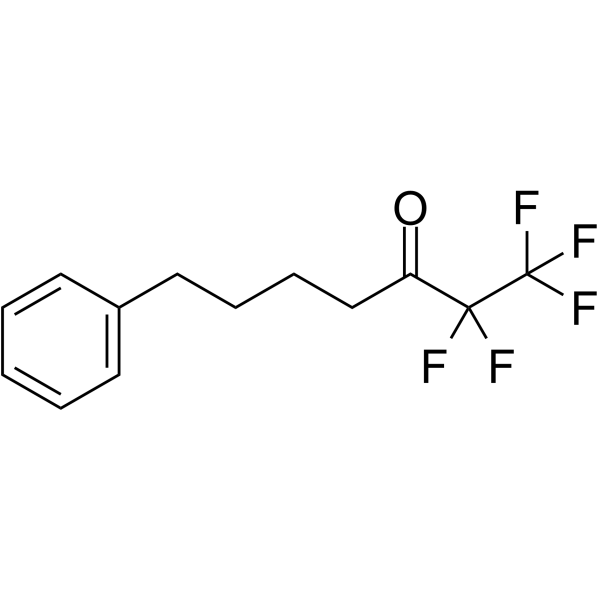
-
- HY-Y0217
-
|
|
Drug Metabolite
|
|
|
N-Carbethoxy-4-piperidone is a metabolite of Loratadine (HY-17043). Loratadine is a selective inverse peripheral histamine H1-receptor agonist, and shows anti-dengue-virus (DENV) activity .
|
-
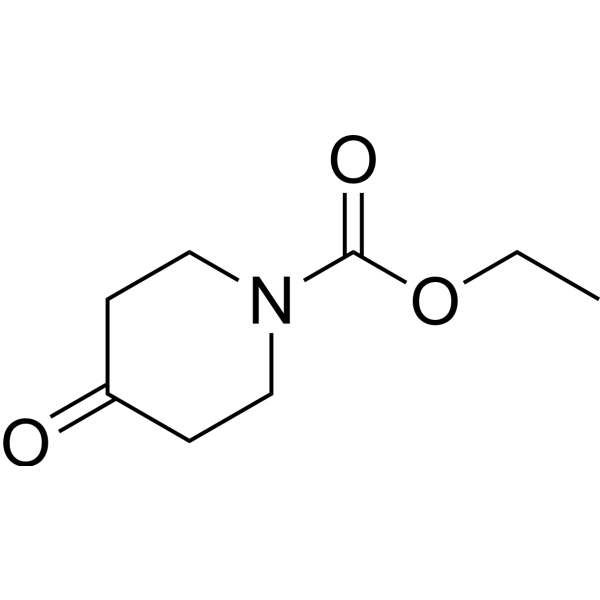
-
- HY-108353
-
-
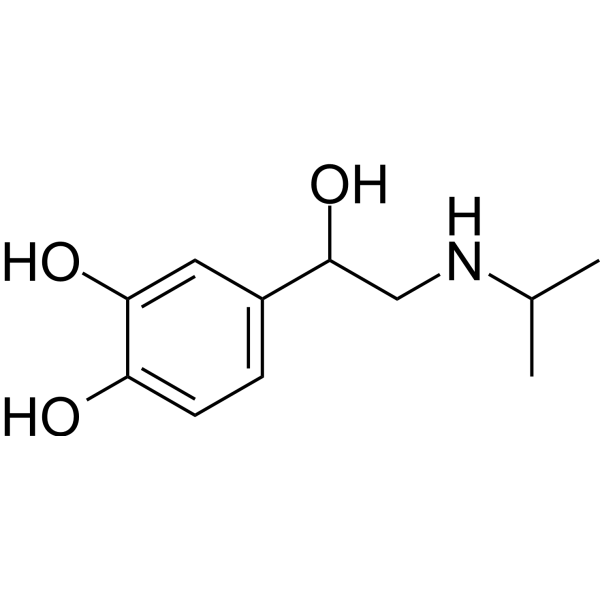
-
- HY-B0468
-
|
Isoproterenol hydrochloride
|
Adrenergic Receptor
Endogenous Metabolite
|
Cardiovascular Disease
Endocrinology
|
|
Isoprenaline (Isoproterenol) hydrochloride is a non-selective, orally active β-adrenergic receptor agonist. Isoprenaline has potent peripheral vasodilator, bronchodilator, and cardiac stimulating activities. Isoprenaline can be used for the research of bradycardia and bronchial asthma .
|
-

-
- HY-108353A
-
-
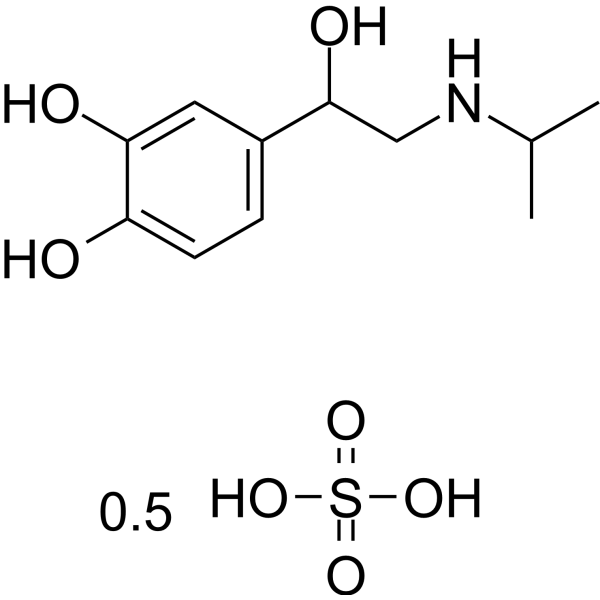
-
- HY-153963
-
|
|
Oxytocin Receptor
|
Endocrinology
|
|
PF-06655075 is a novel andnon–brain-penetrant oxytocin receptor agonist with increased selectivity for the oxytocin receptor and significantly increased pharmacokinetic stability. PF-06655075 can be used as a tool compound to further explore the role of peripheral oxytocin in behavioral response .
|
-
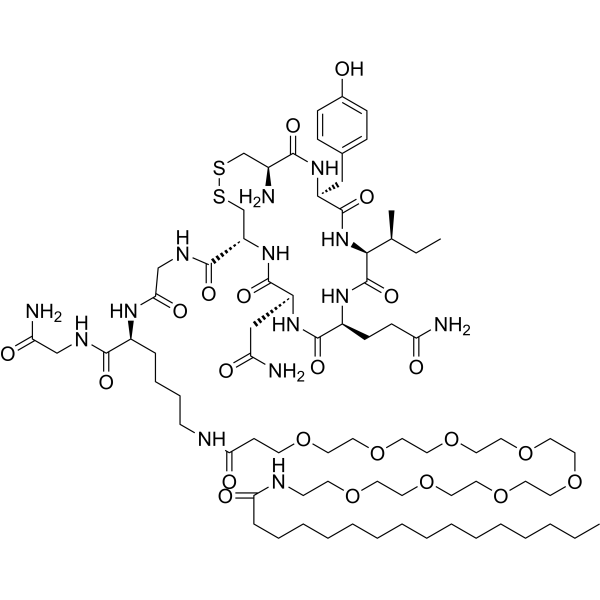
-
- HY-B0347S1
-
|
|
Apoptosis
Caspase
Calcium Channel
Reactive Oxygen Species
|
Cardiovascular Disease
|
|
Lacidipine- 13C8 is the deuterium labeled Lacidipine[1]. Lacidipine is an orally active and highly selective L-type calcium channel blocker that acts on smooth muscle calcium channels, primarily dilates peripheral arteries, reduces peripheral resistance, and has long-lasting anti-hypertensive activity. Lacidipine protects HKCs from apoptosis induced by ATP depletion and recovery by modulating the caspase-3 pathway. Lacidipine can be used in studies of hypertension, atherosclerosis and acute kidney injury (AKI)[2][3].
|
-

-
- HY-B0347S3
-
|
|
Calcium Channel
Caspase
Reactive Oxygen Species
Apoptosis
Isotope-Labeled Compounds
|
Cardiovascular Disease
|
|
Lacidipine- 13C4 is 13C labeled Lacidipine (HY-B0347). Lacidipine is an orally active and highly selective L-type calcium channel blocker that acts on smooth muscle calcium channels, primarily dilates peripheral arteries, reduces peripheral resistance, and has long-lasting anti-hypertensive activity. Lacidipine protects HKCs from apoptosis induced by ATP depletion and recovery by modulating the caspase-3 pathway. Lacidipine can be used in studies of hypertension, atherosclerosis and acute kidney injury (AKI) .
|
-
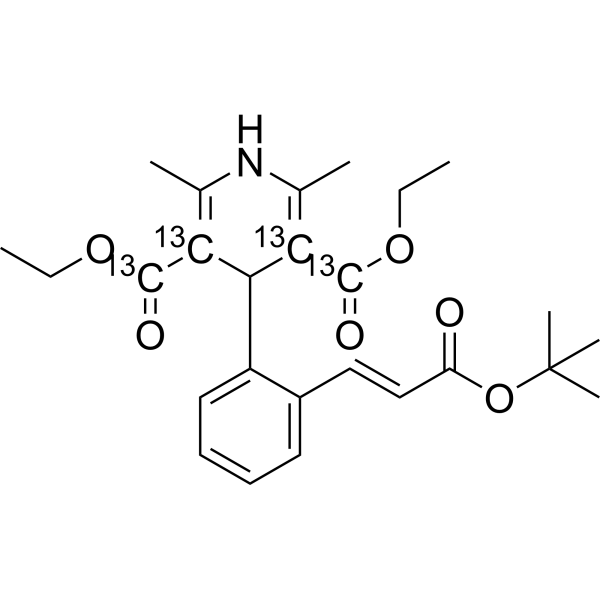
-
- HY-B0347R
-
|
|
Calcium Channel
Reactive Oxygen Species
Caspase
Apoptosis
|
Cardiovascular Disease
|
|
Lacidipine (Standard) is the analytical standard of Lacidipine. This product is intended for research and analytical applications. Lacidipine is an orally active and highly selective L-type calcium channel blocker that acts on smooth muscle calcium channels, primarily dilates peripheral arteries, reduces peripheral resistance, and has long-lasting anti-hypertensive activity. Lacidipine protects HKCs from apoptosis induced by ATP depletion and recovery by modulating the caspase-3 pathway. Lacidipine can be used in studies of hypertension, atherosclerosis and acute kidney injury (AKI) .
|
-

-
- HY-101610
-
-

-
- HY-B0311AS
-
|
(S)-(-)-Carbidopa-d3 (monohydrate)
|
Aryl Hydrocarbon Receptor
|
Neurological Disease
Cancer
|
|
Carbidopa-d3 (monohydrate) is the deuterium labeled Carbidopa monohydrate. Carbidopa ((S)-(-)-Carbidopa) monohydrate, a peripheral decarboxylase inhibitor, can be used for the research of Parkinson's disease. Carbidopa monohydrate is a selective aryl hydrocarbon receptor (AhR) modulator. Carbidopa monohydrate inhibits pancreatic cancer cell and tumor growth[1][2].
|
-

-
- HY-P99019
-
|
TEV-48125
|
CGRP Receptor
|
Neurological Disease
|
|
Fremanezumab (TEV-48125) is a humanized IgG2a monoclonal antibody that selectively and potently binds to calcitonin gene-related peptide (CGRP). CGRP is a 37-amino acid neuropeptide involved in central and peripheral pathophysiological events of migraine. Fremanezumab has the potential for chronic migraine research .
|
-

-
- HY-154832
-
|
|
Calcium Channel
|
Cardiovascular Disease
|
|
Cav 3.2 inhibitor 4 (compound 21) is a potent, peripherally restricted, selective T-type calcium channel (Cav3.2) inhibitor, with an IC50 of 0.6 μM. Cav 3.2 inhibitor 4 can be used for the research of atrial fibrillation .
|
-
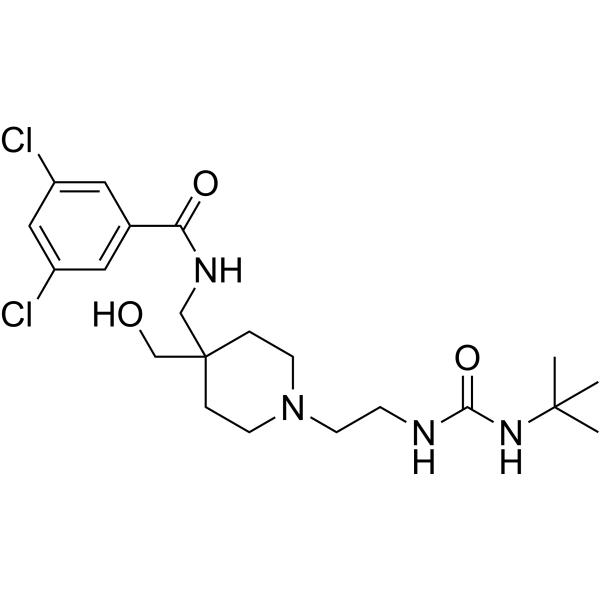
-
- HY-118064
-
|
LY-368975
|
Others
|
Neurological Disease
|
|
(R)-Thionisoxetine is a potent and selective inhibitor of central and peripheral norepinephrine (NE) uptake. (R)-thionisoxetine prevented hypothalamic NE depletion by 6-hydroxydopamine with an ED50 of 0.21 mg/kg. (R)-Thionisoxetine can be used for the research of a variety of diseases including depression and urinary incontinence .
|
-

- HY-B0311S1
-
|
(S)-(-)-Carbidopa-d3
|
Aryl Hydrocarbon Receptor
Isotope-Labeled Compounds
|
Neurological Disease
|
|
Carbidopa-d3-1 is the deuterium labeled Carbidopa (HY-B0311). Carbidopa, a peripheral decarboxylase inhibitor, can be used for the research of Parkinson's disease. Carbidopa is a selective aryl hydrocarbon receptor (AhR) modulator. Carbidopa inhibits pancreatic cancer cell and tumor growth .
|
-

- HY-B0362A
-
|
Phentolamine methanesulfonate
|
Adrenergic Receptor
|
Cardiovascular Disease
Endocrinology
Cancer
|
|
Phentolamine mesylate (Phentolamine methanesulfonate) is a reversible, non-selective, and orally active blocker of α1 and α2 adrenergic receptor that expands blood vessels to reduce peripheral vascular resistance. Phentolamine mesylate can be used for the research of pheochromocytoma-related hypertension, heart failure and erectile dysfunction .
|
-

- HY-17043S
-
-

- HY-17043S1
-
-

- HY-18977
-
KML29
2 Publications Verification
|
MAGL
|
Metabolic Disease
Inflammation/Immunology
|
|
KML29 is an extremely selective, orally active and irreversible MAGL inhibitor, with IC50 values of 15 nM, 43 nM and 5.9 nM for mouse, rat and human MAGL, respectively. KML29 exhibits minimal cross-reactivity toward other central and peripheral serine hydrolases, including no detectable activity against FAAH .
|
-

- HY-101176
-
|
|
Melatonin Receptor
|
Cancer
|
|
2-Iodomelatonin is a potent agonist of melatonin receptor 1 (MT1) with a Ki value of 28 pM, it is more 5-fold selective for MT1 over MT2 . 2-iodomelatonin can be used to identify, characterize and localize melatonin binding sites in the brain and peripheral tissues .
|
-
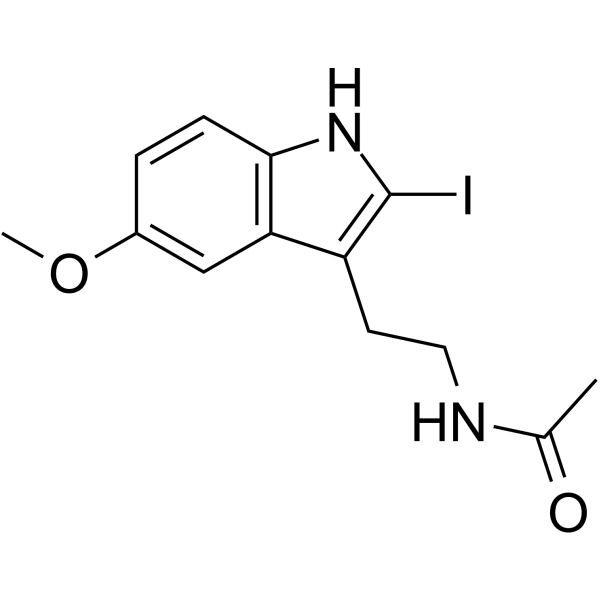
- HY-16100
-
|
|
Fatty Acid Synthase (FASN)
|
Metabolic Disease
Cancer
|
|
BI 99179 is a potent and selective type I fatty acid synthase (FAS) inhibitor with an IC50 of 79 nM. BI 99179 is a tool compound suitable for the in vivo validation of FAS as a target for lipid metabolism related diseases. BI 99179 exhibits significant exposure (both peripheral and central) upon oral administration in rats .
|
-
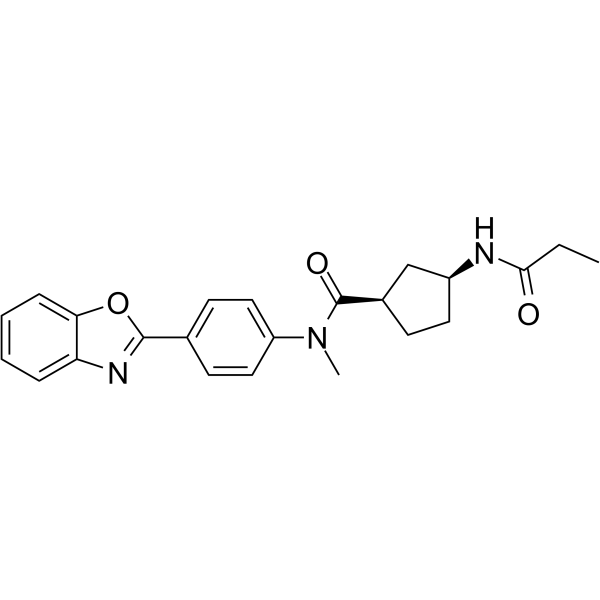
- HY-17406
-
|
Ro 40-7592
|
COMT
Amyloid-β
Apoptosis
|
Neurological Disease
Cancer
|
|
Tolcapone (Ro 40-7592) is a selective, orally active and powerful mixed (peripheral and central) COMT inhibitor with an IC50 of 773 nM in the liver . Tolcapone is also a potent inhibitor of α-syn and Aβ42 oligomerization and fibrillogenesis . Tolcapone induces oxidative stress leading to apoptosis and inhibition of tumor growth in neuroblastoma .
|
-
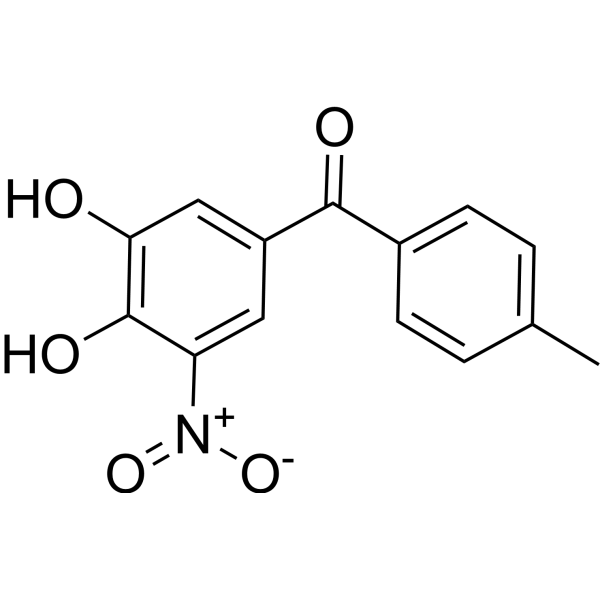
- HY-107322
-
|
Mepirodipine hydrochloride; YM-09730-5
|
Calcium Channel
|
Cardiovascular Disease
|
|
Barnidipine hydrochloride (Mepirodipine hydrochloride) is an L-type calcium antagonist (CaA) with high affinity for [ 3H] initrendipine binding sites (Ki=0.21 nmol/l), has selective action against CaA receptors . Barnidipine hydrochloride (Mepirodipine hydrochloride) is an antihypertensive agent and acts by the reduction of peripheral vascular resistance secondary to its vasodilatory action .
|
-
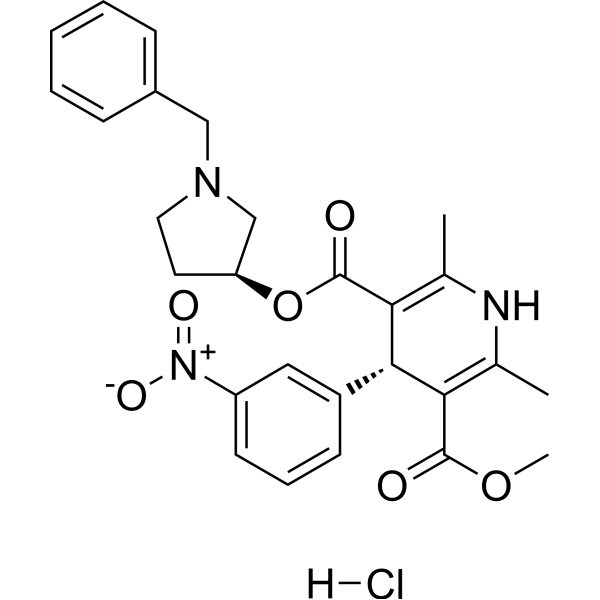
- HY-107322A
-
|
Mepirodipine; YM-09730-5 Free base
|
Calcium Channel
|
Cardiovascular Disease
|
|
Barnidipine (Mepirodipine) is an L-type calcium antagonist (CaA) with high affinity for [ 3H] initrendipine binding sites (Ki=0.21 nmol/l), has selective action against CaA receptors . Barnidipine (Mepirodipine) is an antihypertensive agent and acts by the reduction of peripheral vascular resistance secondary to its vasodilatory action .
|
-
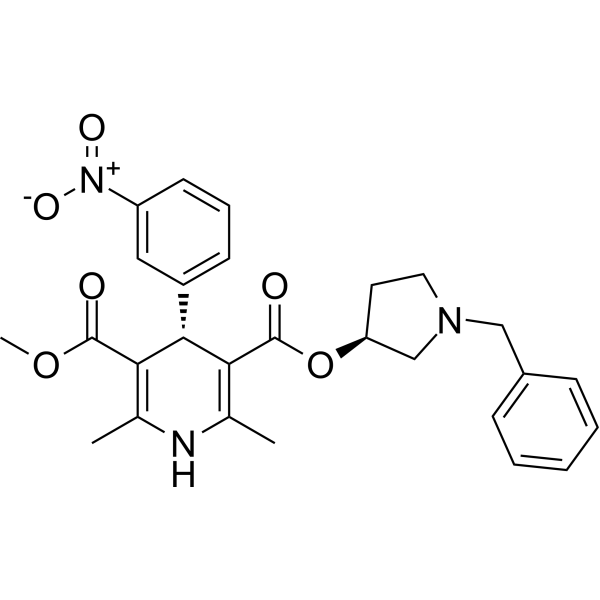
- HY-144126
-
|
|
LPL Receptor
|
Inflammation/Immunology
|
|
S1P1 agonist 5 is a selective and orally active S1P1 agonist. S1P1 agonist 5 inhibits the lymphocyte egress from the lymphoid tissue to the peripheral blood. S1P1 agonist 5 has the potential for the research of multiple sclerosis (MS) .
|
-
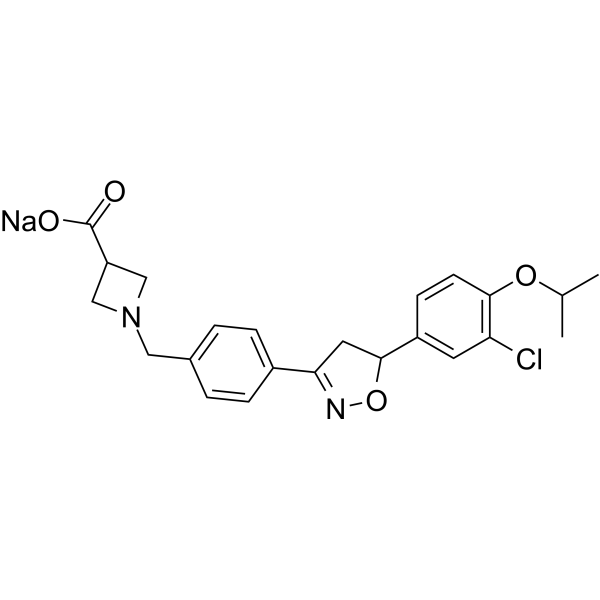
- HY-17043R
-
|
|
|
Infection
Inflammation/Immunology
Endocrinology
Cancer
|
|
Loratadine (Standard) is the analytical standard of Loratadine. This product is intended for research and analytical applications. Loratadine (SCH-29851) is a selective inverse peripheral histamine H1-receptor agonist with an IC50 of >32 μM. Loratadine has anti-dengue-virus (DENV) activity. Loratadine can inhibit immunologic release of inflammatory mediators.
|
-

- HY-B0715
-
|
BL-191; PTX; Oxpentifylline
|
Phosphodiesterase (PDE)
Autophagy
HIV
|
Cardiovascular Disease
Cancer
|
|
Pentoxifylline (BL-191), a haemorheological agent, is an orally active non-selective phosphodiesterase (PDE) inhibitor, with immune modulation, anti-inflammatory, hemorheological, anti-fibrinolytic and anti-proliferation effects. Pentoxifylline can be used for the research of peripheral vascular disease, cerebrovascular disease and a number of other conditions involving a defective regional microcirculation .
|
-

- HY-138568
-
|
|
MAP4K
|
Inflammation/Immunology
|
|
HPK1-IN-3 is a potent and selective ATP-competitive hematopoietic progenitor kinase 1 (HPK1; MAP4K1) inhibitor with an IC50 of 0.25 nM. HPK1-IN-3 has IL-2 cellular potency with an EC50 of 108 nM in human peripheral blood mononuclear cells (PBMCs) .
|
-
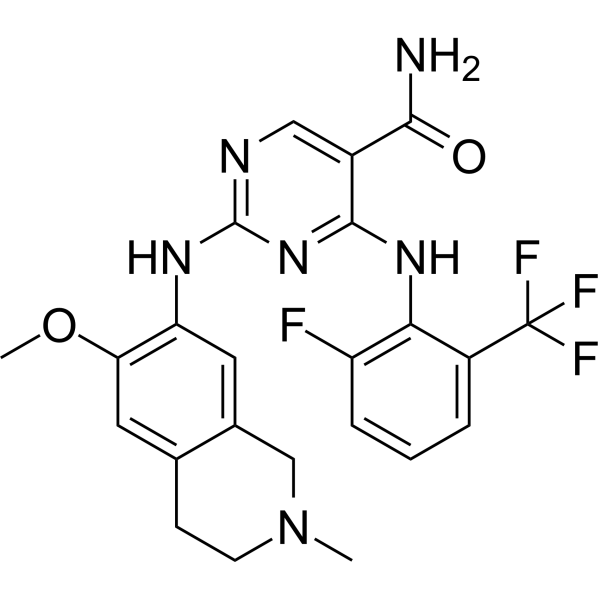
- HY-150728
-
|
|
Cholinesterase (ChE)
|
Neurological Disease
|
|
AChE-IN-22 (compound 10q) is a selective acetylcholinesterase (AChE) inhibitor against AChE and BuChE with the IC50 values of 0.88 μM and 10 μM, respectively. AChE-IN-22 can bind to both the CAS (catalytic active site) and PAS (peripheral anionic site) of AChE and has the potential for the research of Alzheimer's disease .
|
-
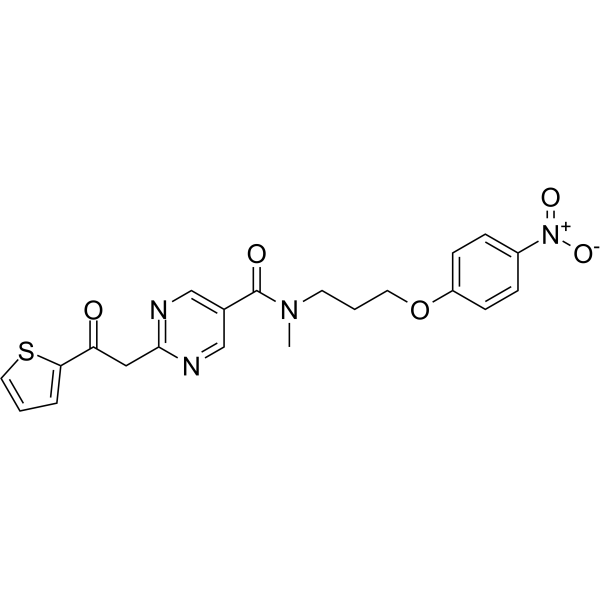
- HY-12717AS
-
|
|
Isotope-Labeled Compounds
Adrenergic Receptor
|
Cardiovascular Disease
Endocrinology
|
|
Phentolamine-d4 (hydrochloride) is the deuterium labeled Phentolamine hydrochloride. Phentolamine hydrochloride is a reversible, non-selective, and orally active blocker of α1 and α2 adrenergic receptor that expands blood vessels to reduce peripheral vascular resistance. Phentolamine hydrochloride can be used for the research of pheochromocytoma-related hypertension, heart failure and erectile dysfunction[1][2][3].
|
-
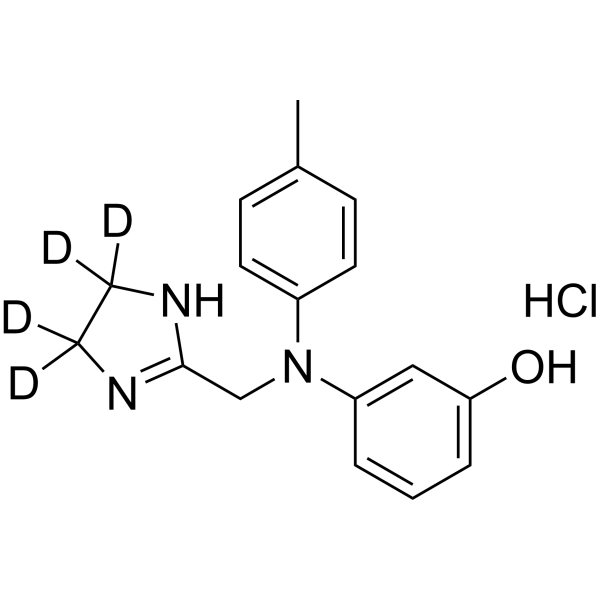
- HY-112340
-
|
|
Cannabinoid Receptor
|
Metabolic Disease
|
|
CB1 antagonist 4 (compound 8) is a peripheral selective cannabinoid receptor type 1 (CB1) receptor antagonist. CB1 antagonist 4 shows limited penetrance to the brain in order to minimize or prevent CNS adverse reactions, and preserves potential antiobesity effects. CB1 antagonist 4 reduces propensity for psychiatric side effects .
|
-
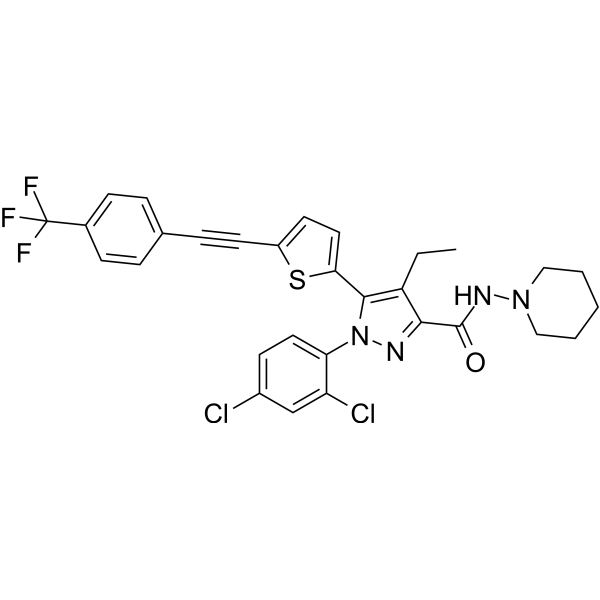
- HY-146662
-
|
|
PGE synthase
|
Inflammation/Immunology
|
|
HPGDS inhibitor 3 is an orally active and highly potent peripherally restricted hematopoietic prostaglandin D synthase (H-PGDS) inhibitor with IC50 value of 9.4 nM and EC50 of 42 nM, respectively. HPGDS inhibitor 3 exhibits good selectivity, good pharmacokinetic parameters in mouse, rat, and dog, and no CNS toxicity. HPGDS inhibitor 3 has anti-inflammatory activity .
|
-
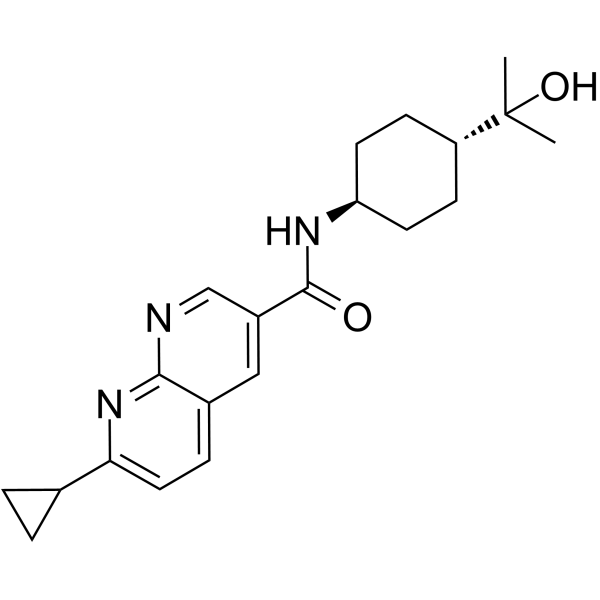
- HY-153963A
-
|
|
Oxytocin Receptor
|
Endocrinology
|
|
PF-06655075 (TFA) is the TFA form of PF-06655075 (HY-153963). PF-06655075 is a novel andnon–brain-penetrant oxytocin receptor agonist with increased selectivity for the oxytocin receptor and significantly increased pharmacokinetic stability. PF-06655075 can be used as a tool compound to further explore the role of peripheral oxytocin in behavioral response .
|
-

- HY-B0715S
-
|
BL-191-d6; PTX-d6; Oxpentifylline-d6
|
Phosphodiesterase (PDE)
Autophagy
HIV
|
Cardiovascular Disease
Cancer
|
|
Pentoxifylline-d6 is the deuterium labeled Pentoxifylline. Pentoxifylline (BL-191), a haemorheological agent, is an orally active non-selective phosphodiesterase (PDE) inhibitor, with immune modulation, anti-inflammatory, hemorheological, anti-fibrinolytic and anti-proliferation effects. Pentoxifylline can be used for the research of peripheral vascular disease, cerebrovascular disease and a number of other conditions involving a defective regional microcirculation[1][2][3].
|
-

- HY-17406S1
-
|
Ro 40-7592-d4
|
Isotope-Labeled Compounds
COMT
Amyloid-β
Apoptosis
|
Neurological Disease
Cancer
|
|
Tolcapone-d4 is the deuterium labeled Tolcapone. Tolcapone (Ro 40-7592) is a selective, orally active and powerful mixed (peripheral and central) COMT inhibitor with an IC50 of 773 nM in the liver[1]. Tolcapone is also a potent inhibitor of α-syn and Aβ42 oligomerization and fibrillogenesis[2]. Tolcapone induces oxidative stress leading to apoptosis and inhibition of tumor growth in neuroblastoma[3].
|
-

- HY-B0715S2
-
|
BL-191-d5; PTX-d5; Oxpentifylline-d5
|
Phosphodiesterase (PDE)
Autophagy
HIV
|
Cardiovascular Disease
Cancer
|
|
Pentoxifylline-d5 is the deuterium labeled Pentoxifylline. Pentoxifylline (BL-191), a haemorheological agent, is an orally active non-selective phosphodiesterase (PDE) inhibitor, with immune modulation, anti-inflammatory, hemorheological, anti-fibrinolytic and anti-proliferation effects. Pentoxifylline can be used for the research of peripheral vascular disease, cerebrovascular disease and a number of other conditions involving a defective regional microcirculation[1][2][3].
|
-

- HY-10061
-
|
AZD-3355
|
GABA Receptor
|
Metabolic Disease
|
|
Lesogaberan (AZD-3355) is a potent and selective GABAB receptor agonist with an EC50 of 8.6 nM for human recombinant GABAB receptors. The affinity (Kis) of Lesogaberan for rat GABAB and GABAA receptors, as measured by displacement of [ 3H]GABA binding in brain membranes: 5.1 nM and 1.4 μM, respectively. Lesogaberan inhibits transient lower esophageal sphincter relaxation through a peripheral mode of action .
|
-
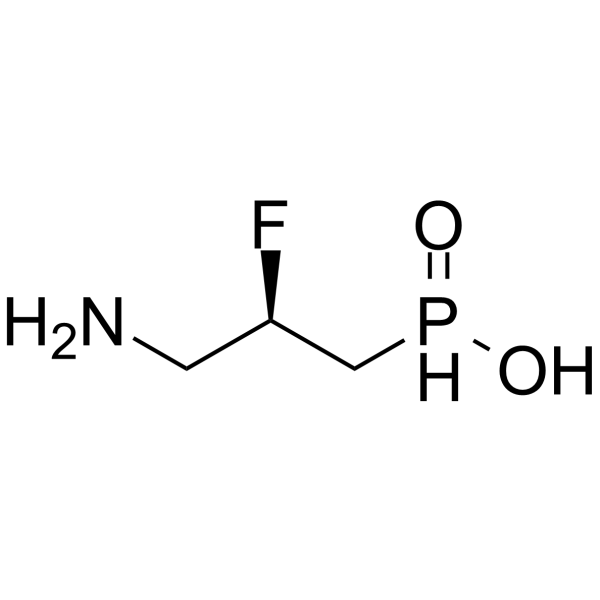
- HY-10061B
-
|
AZD-3355 hydrochloride
|
GABA Receptor
|
Metabolic Disease
|
|
Lesogaberan (AZD-3355) hydrochloride is a potent and selective GABAB receptor agonist with an EC50 of 8.6 nM for human recombinant GABAB receptor. The affinity (Kis) of Lesogaberan hydrochloride for rat GABAB and GABAA receptors, as measured by displacement of [ 3H]GABA binding in brain membranes: 5.1 nM and 1.4 μM, respectively. Lesogaberan hydrochloride inhibits transient lower esophageal sphincter relaxation through a peripheral mode of action .
|
-
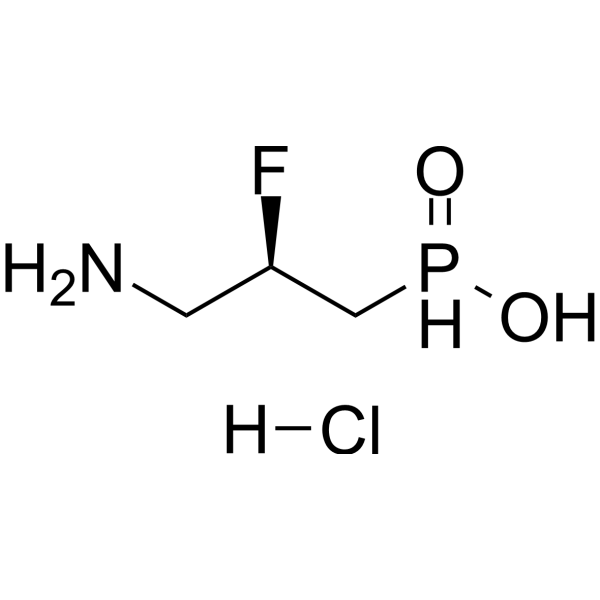
- HY-107322S
-
|
Mepirodipine-d5 hydrochloride; YM-09730-5-d5 hydrochloride
|
Isotope-Labeled Compounds
Calcium Channel
|
Cardiovascular Disease
|
|
Barnidipine-d5 (hydrochloride) is the deuterium labeled Barnidipine hydrochloride. Barnidipine hydrochloride (Mepirodipine hydrochloride) is an L-type calcium antagonist (CaA) with high affinity for [3H] initrendipine binding sites (Ki=0.21 nmol/l), has selective action against CaA receptors[1].Barnidipine hydrochloride (Mepirodipine hydrochloride) is an antihypertensive agent and acts by the reduction of peripheral vascular resistance secondary to its vasodilatory action[2].
|
-

- HY-156278
-
|
|
Apoptosis
Autophagy
|
Cancer
|
|
FB49 is a highly selective inhibitor of Bcl-2-associated athanogene 3 (BAG3), with the Ki of 45 μM. FB49 inhibits the cell growth in human tumoral cells, but has no toxicity in human peripheral mononuclear cells. FB49 block cell cycle in G1 phase and to induce apoptosis as well as autophagy in medulloblastoma HD-MB03 treated cells .
|
-

- HY-10061A
-
|
AZD-3355 napadisylate
|
GABA Receptor
|
Metabolic Disease
|
|
Lesogaberan (AZD-3355) napadisylate is a potent and selective GABAB receptor agonist with an EC50 of 8.6 nM for human recombinant GABAB receptors. The affinity (Kis) of Lesogaberan napadisylate for rat GABAB and GABAA receptors, as measured by displacement of [ 3H]GABA binding in brain membranes: 5.1 nM and 1.4 μM, respectively. Lesogaberan napadisylate inhibits transient lower esophageal sphincter relaxation through a peripheral mode of action .
|
-

- HY-147907
-
|
|
Adenosine Receptor
|
Neurological Disease
Inflammation/Immunology
Cancer
|
|
Adenosine receptor inhibitor 1 is a potent and selective adenosine receptor (AR) inhibitor with Ki values of >1000, 68.5, >1000, >1000 nM for A1AR, A2AAR, A2BAR, A3AR, respectively. Adenosine receptor inhibitor 1 shows antinociceptive activity, anti-inflammatory effect and peripheral analgesic effect. Adenosine receptor inhibitor 1 has the potential for the research of cancer or neurodegenerative diseases .
|
-
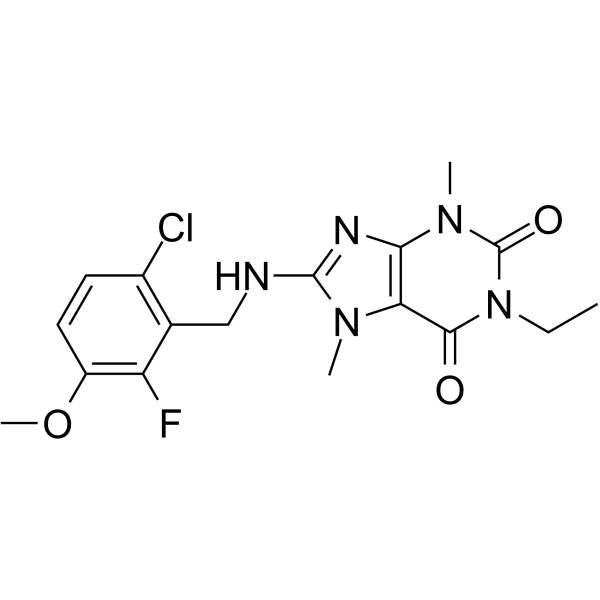
- HY-B0002B
-
|
GR 38032; SN 307
|
5-HT Receptor
|
Neurological Disease
Cancer
|
|
Ondansetron (GR 38032; SN 307) is a highly selective 5-HT3 receptor antagonist, with IC50 value of 103 pM. Ondansetron exerts antiemetic effects by antagonizing 5-HT receptor located on local neurons in the peripheral and central nervous system. Ondansetron suppresses nausea and vomiting caused by chemotherapy and radiation therapy. Ondansetron has orally bioactivity .
|
-

- HY-118250
-
|
|
Toll-like Receptor (TLR)
IFNAR
TNF Receptor
|
Inflammation/Immunology
|
|
GSK2245035 is a highly potent and selective intranasal Toll-Like receptor 7 (TLR7) agonist with preferential Type-1 interferon (IFN)-stimulating properties. GSK2245035 has pEC50s of 9.3 and 6.5 for IFNα and TFNα. GSK2245035 effectively suppresses allergen-induced Th2 cytokine production in human peripheral blood cell cultures. GSK2245035 is used for asthma .
|
-
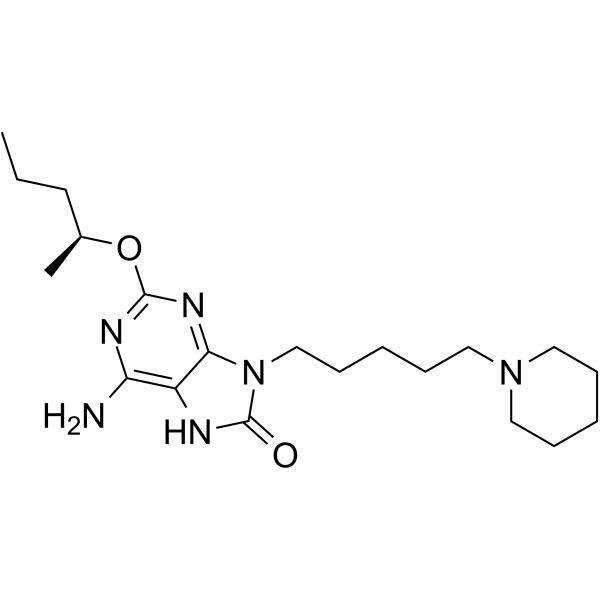
- HY-B1021
-
|
|
Free Fatty Acid Receptor
|
Cardiovascular Disease
Metabolic Disease
|
|
Vincamine is a monoterpenoid indole alkaloid extracted from the Madagascar periwinkle. Vincamine is a peripheral vasodilator and exerts a selective vasoregulator action on the brain microcapilar circulation . Vincamine is a GPR40 agonist and acts as a β-cell protector by ameliorating β-cell dysfunction and promoting glucose-stimulated insulin secretion (GSIS). Vincamine improves glucose homeostasis in vivo, and has the potential for the type 2 diabetes mellitus (T2DM) research .
|
-

- HY-19969
-
|
|
Interleukin Related
|
Inflammation/Immunology
|
|
YM-90709 is a novel IL-5 inhibitor which selectively blocks the binding of IL-5 to the IL-5 receptor (IL-5R).YM-90709 potently inhibits the binding of [ 125I]-IL-5 to IL-5R on human peripheral eosinophils and eosinophilic HL-60 clone 15 cells with IC50 values of 1.0 and 0.57 μM .
|
-
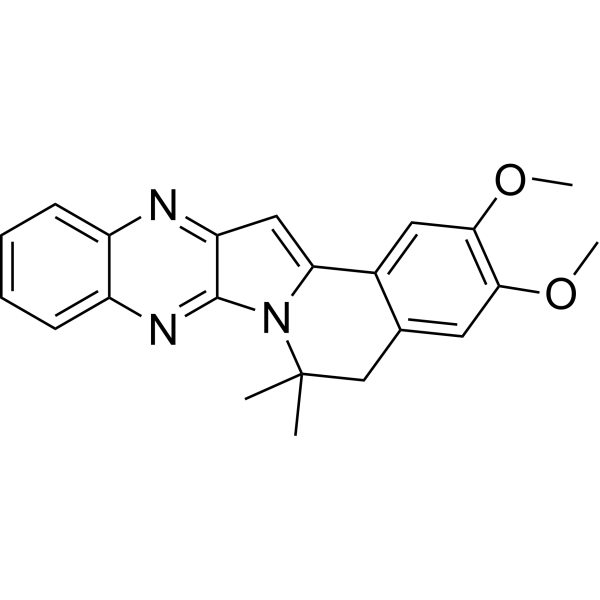
- HY-P5869
-
|
|
Calcium Channel
Sodium Channel
|
Neurological Disease
|
|
Kurtoxin is a selective Cav3 (T-type) voltage-gated Ca 2+ channel gating inhibitor with a Kd of 15 nM for Cav3.1 (α1G T-type) Ca 2+ channel. Kurtoxin can interact with high affinity with native neuronal high-threshold L-type, N-type, and P-type Ca 2+ channels in central and peripheral neurons. Kurtoxin also shows cross-reactivity with voltage-gated Na + channel .
|
-

- HY-107322AS1
-
|
Mepirodipine-d5; YM-09730-5-d5 Free base
|
Isotope-Labeled Compounds
|
Others
|
|
Barnidipine-d5 is the deuterium-labeled Barnidipine (HY-107322A). Barnidipine-d5 (Mepirodipine) is an L-type calcium antagonist (CaA) with high affinity for [ 3H] initrendipine binding sites (Ki=0.21 nmol/l), has selective action against CaA receptors . Barnidipine-d5 (Mepirodipine) is an antihypertensive agent and acts by the reduction of peripheral vascular resistance secondary to its vasodilatory action .
|
-

- HY-156730A
-
|
|
Molecular Glues
STAT
|
Cancer
|
|
KT-333 ammonium (Compound A) is a molecular glues that degrades STAT3 protein. KT-333 ammonium mediates the selective degradation of STAT3 through the ubiquitin-proteasome system by binding to STAT3 protein and E3 ubiquitin ligase von Hippel-Lindau protein (VHL). KT-333 ammonium has strong selectivity for STAT3 protein degradation and good antitumor activity. KT-333 ammonium can be used in the study of hematologic malignancies such as large granular lymphocytic leukemia (LGL-L), peripheral T-cell lymphoma (PTCL), and cutaneous T-cell lymphoma (CTCL) .
|
-

- HY-13106
-
|
EMA401; PD-126055
|
Angiotensin Receptor
|
Neurological Disease
Endocrinology
|
|
Olodanrigan (EMA401) is a highly selective, orally active, peripherally restricted angiotensin II type 2 receptor (AT2R) antagonist. It is under development as a neuropathic pain therapeutic agent. Olodanrigan (EMA401) analgesic action appears to involve inhibition of augmented AngII/AT2R induced p38 and p42/p44 MAPK activation, and hence inhibition of DRG neuron hyperexcitability and sprouting of DRG neurons .
|
-
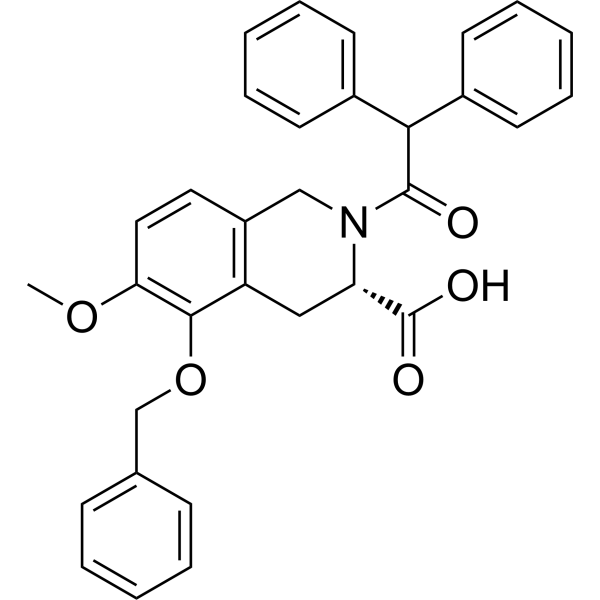
- HY-P1220
-
|
|
Sodium Channel
|
Neurological Disease
|
|
Huwentoxin-IV is a potent and selective sodium channel blocker, inhibits neuronal Nav1.7, Nav1.2, Nav1.3 and Nav1.4 with IC50s of 26, 150, 338 and 400 nM, respectively. Huwentoxin-IV preferentially blocks peripheral nerve subtype Nav1.7 by binding neurotoxin receptor site 4. Huwentoxin-IV has analgesic effects on animal models of inflammatory and neuropathic pain .
|
-

- HY-P1220A
-
|
|
Sodium Channel
|
Neurological Disease
|
|
Huwentoxin-IV TFA is a potent and selective sodium channel blocker, inhibits neuronal Nav1.7, Nav1.2, Nav1.3 and Nav1.4 with IC50s of 26, 150, 338 and 400 nM, respectively. Huwentoxin-IV TFA preferentially blocks peripheral nerve subtype Nav1.7 by binding neurotoxin receptor site 4. Huwentoxin-IV TFA has analgesic effects on animal models of inflammatory and neuropathic pain .
|
-

- HY-13106A
-
|
EMA401 sodium; PD-126055 sodium
|
Angiotensin Receptor
|
Neurological Disease
Endocrinology
|
|
Olodanrigan (EMA401) sodium is a highly selective, orally active, peripherally restricted angiotensin II type 2 receptor (AT2R) antagonist. Olodanrigan sodium is under development as a neuropathic pain therapeutic agent. Olodanrigan sodium analgesic action appears to involve inhibition of augmented AngII/AT2R induced p38 and p42/p44 MAPK activation, and hence inhibition of DRG neuron hyperexcitability and sprouting of DRG neurons .
|
-
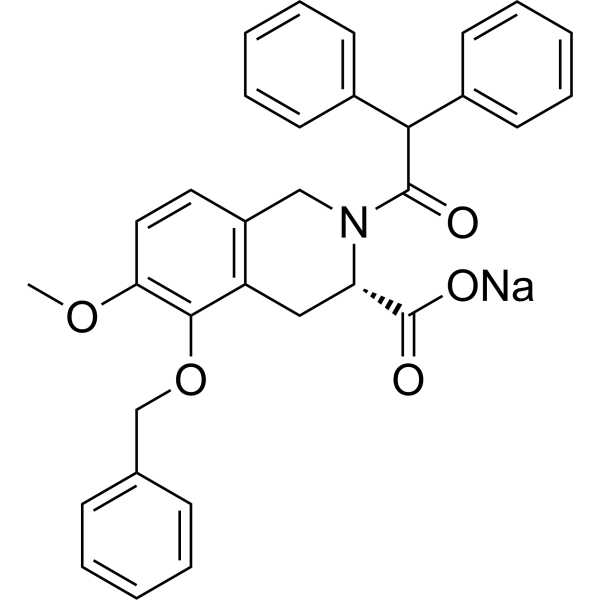
- HY-B0002BR
-
|
|
|
Neurological Disease
Cancer
|
|
Ondansetron (Standard) is the analytical standard of Ondansetron. This product is intended for research and analytical applications. Ondansetron (GR 38032; SN 307) is a highly selective 5-HT3 receptor antagonist, with IC50 value of 103 pM. Ondansetron exerts antiemetic effects by antagonizing 5-HT receptor located on local neurons in the peripheral and central nervous system. Ondansetron suppresses nausea and vomiting caused by chemotherapy and radiation therapy. Ondansetron has orally bioactivity .
|
-

- HY-P3019
-
|
|
CRFR
|
Cardiovascular Disease
Neurological Disease
Endocrinology
|
|
Urocortin III (human) is a corticotropin-releasing factor (CRF)-related peptide. Urocortin III (human) preferentially binds and activates CRF-R2 and has a discrete central nervous system and peripheral distribution. Urocortin III (human) selectively binds to type 2 CRF receptors with Ki values of 13.5, 21.7, and >100 nM for mCRF2β, rCRF2α, and hCRF1, respectively. Urocortin III (human) mediates somatostatin-dependent negative feedback control of Insulin (human) (HY-P0035) secretion .
|
-
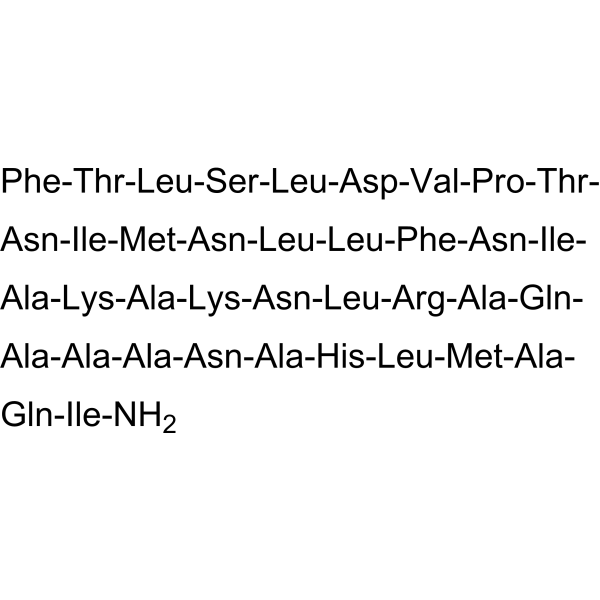
- HY-B1021R
-
|
|
Free Fatty Acid Receptor
|
Cardiovascular Disease
Metabolic Disease
|
|
Vincamine (Standard) is the analytical standard of Vincamine. This product is intended for research and analytical applications. Vincamine is a monoterpenoid indole alkaloid extracted from the Madagascar periwinkle. Vincamine is a peripheral vasodilator and exerts a selective vasoregulator action on the brain microcapilar circulation . Vincamine is a GPR40 agonist and acts as a β-cell protector by ameliorating β-cell dysfunction and promoting glucose-stimulated insulin secretion (GSIS). Vincamine improves glucose homeostasis in vivo, and has the potential for the type 2 diabetes mellitus (T2DM) research .
|
-

- HY-14280
-
|
|
COMT
|
Neurological Disease
Cancer
|
|
Entacapone is a potent, reversible, peripherally acting and orally active catechol-O-methyltransferase (COMT) inhibitor. Entacapone inhibits COMT from rat brain, erythrocytes and liver with IC50 values of 10 nM, 20 nM, and 160 nM, respectively. Entacapone is selective for COMT over other catecholamine metabolizing enzymes, including MAO-A, MAO-B, phenolsulphotransferase M (PST-M) and PST-P (IC50s>50 µM). Entacapone can be used for the research of Parkinson's disease . Entacapone serves as a inhibitor of FTO demethylation with an IC50 of 3.5 μM, can be used for the research of metabolic disorders .
|
-
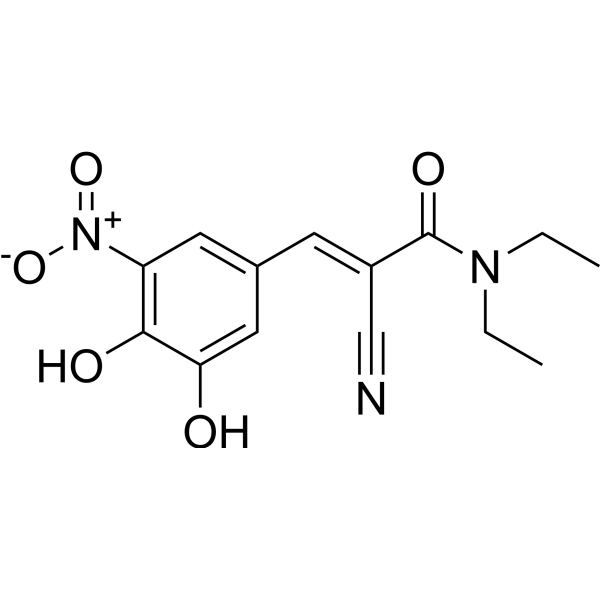
- HY-14280A
-
|
|
COMT
|
Neurological Disease
|
|
Entacapone sodium salt is a potent, reversible, peripherally acting and orally active catechol-O-methyltransferase (COMT) inhibitor. Entacapone sodium salt inhibits COMT from rat brain, erythrocytes and liver with IC50 values of 10 nM, 20 nM, and 160 nM, respectively. Entacapone sodium salt is selective for COMT over other catecholamine metabolizing enzymes, including MAO-A, MAO-B, phenolsulphotransferase M (PST-M) and PST-P (IC50s>50 µM). Entacapone sodium salt can be used for the research of Parkinson's disease . Entacapone sodium salt serves as as a inhibit of FTO demethylation with an IC50 of 3.5 μM, can be used for the research of metabolic disorders .
|
-
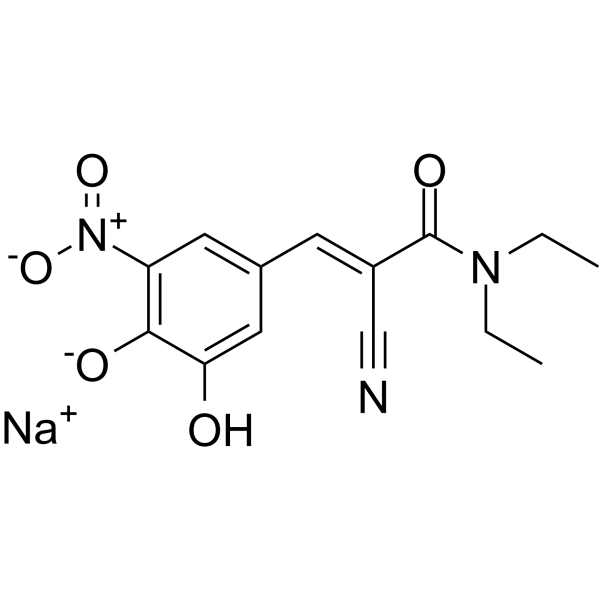
- HY-N4267
-
|
|
Calcium Channel
|
Infection
Cardiovascular Disease
|
|
Yangambin, a furofuran lignan, is already isolated from plants such as member of the Annonaceae family, including species of the genus Rollinia: R. pickeli, R. exalbidaand R. mucosa, as well from the Magnolia biondii. Yangambin, a selective PAF receptor antagonist, inhibits Ca 2+ influx through voltage-gated Ca 2+ channels, leading to the reduction in [Ca 2+]i in vascular smooth muscle cells and consequent peripheral vasodilation . Yangambin exhibits the antiallergic activity against β-hexosaminidase release with an IC50 of 33.8 μM and for anti-inflammatory activity with an IC50 of 37.4 μM .
|
-

- HY-136208
-
|
|
Opioid Receptor
|
Neurological Disease
|
|
TAN-452 is an orally active, selective peripherally acting δ-opioid receptor (DOR) antagonist with a Ki of 0.47 nM and a Kb of 0.21 nM. TAN-452 is an antagonist for μ-opioid receptor (MOR; Ki=36.56 nM and Kb=9.43 nM) and κ-opioid receptor (KOR; Ki=5.31 nM and Kb=7.18 nM). TAN-452, a derivative of Naltrindole, demonstrates low brain penetrability and attenuates morphine-induced side effects without affecting pain control .
|
-
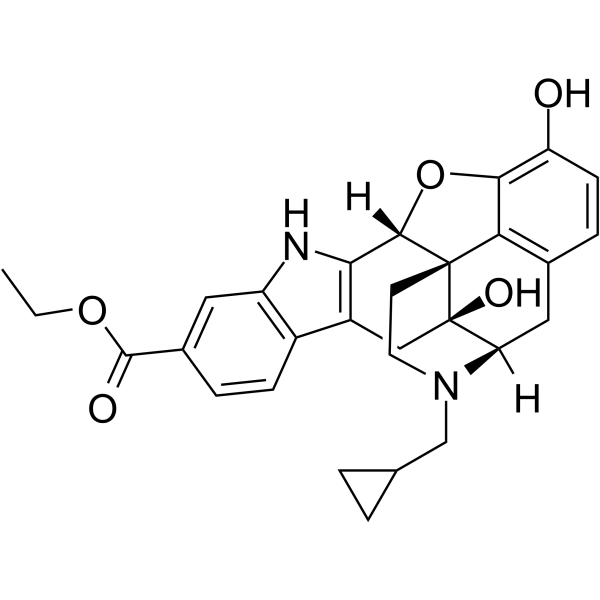
- HY-14280S
-
|
|
COMT
|
Neurological Disease
|
|
Entacapone-d10 is the deuterium labeled Entacapone. Entacapone is a potent, reversible, peripherally acting and orally active catechol-O-methyltransferase (COMT) inhibitor. Entacapone inhibits COMT from rat brain, erythrocytes and liver with IC50 values of 10 nM, 20 nM, and 160 nM, respectively. Entacapone is selective for COMT over other catecholamine metabolizing enzymes, including MAO-A, MAO-B, phenolsulphotransferase M (PST-M) and PST-P (IC50s>50 µM). Entacapone can be used for the research of Parkinson's disease[1]. Entacapone serves as a inhibitor of FTO demethylation with an IC50 of 3.5 μM, can be used for the research of metabolic disorders[2].
|
-
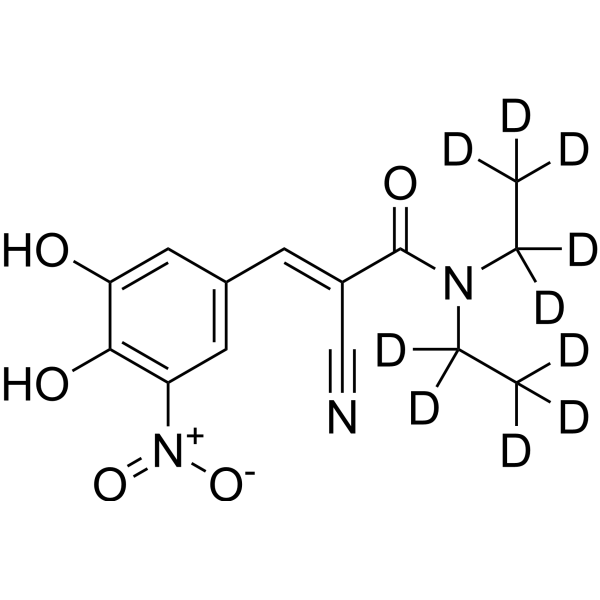
- HY-14280R
-
|
|
COMT
|
Neurological Disease
Cancer
|
|
Entacapone (Standard) is the analytical standard of Entacapone. This product is intended for research and analytical applications. Entacapone is a potent, reversible, peripherally acting and orally active catechol-O-methyltransferase (COMT) inhibitor. Entacapone inhibits COMT from rat brain, erythrocytes and liver with IC50 values of 10 nM, 20 nM, and 160 nM, respectively. Entacapone is selective for COMT over other catecholamine metabolizing enzymes, including MAO-A, MAO-B, phenolsulphotransferase M (PST-M) and PST-P (IC50s>50 µM). Entacapone can be used for the research of Parkinson's disease . Entacapone serves as a inhibitor of FTO demethylation with an IC50 of 3.5 μM, can be used for the research of metabolic disorders .
|
-

| Cat. No. |
Product Name |
Target |
Research Area |
-
- HY-17609
-
|
CR-845; FE-202845
|
Opioid Receptor
|
Neurological Disease
|
|
Difelikefalin (CR-845; FE-202845) is a peripherally restricted and selective agonist of kappa opioid receptor (KOR). Difelikefalin produces anti-inflammatory effects and has the potential in modulating pruritus in conditions such as chronic kidney disease .
|
-
- HY-P3609
-
|
JNJ 38488502; FE 200665
|
Opioid Receptor
|
Neurological Disease
|
|
CR 665 (JNJ 38488502) is a peripherally selective κ-opioid agonist. CR 665 can activate the kappa opioid receptor with EC50 value of 10.9 nM. CR 665 can be used for the research of peripheral pain .
|
-
- HY-P5907
-
|
|
Opioid Receptor
|
Neurological Disease
|
|
Helianorphin-19 is a potent and selective κ-opioid receptor (KOR) activator with a Ki of 21 nM and an EC50 of 45 nM. Helianorphin-19 exhibits strong KOR-specific peripheral analgesic activity in a mouse model of chronic visceral pain .
|
-
- HY-P5869
-
|
|
Calcium Channel
Sodium Channel
|
Neurological Disease
|
|
Kurtoxin is a selective Cav3 (T-type) voltage-gated Ca 2+ channel gating inhibitor with a Kd of 15 nM for Cav3.1 (α1G T-type) Ca 2+ channel. Kurtoxin can interact with high affinity with native neuronal high-threshold L-type, N-type, and P-type Ca 2+ channels in central and peripheral neurons. Kurtoxin also shows cross-reactivity with voltage-gated Na + channel .
|
-
- HY-P1220
-
|
|
Sodium Channel
|
Neurological Disease
|
|
Huwentoxin-IV is a potent and selective sodium channel blocker, inhibits neuronal Nav1.7, Nav1.2, Nav1.3 and Nav1.4 with IC50s of 26, 150, 338 and 400 nM, respectively. Huwentoxin-IV preferentially blocks peripheral nerve subtype Nav1.7 by binding neurotoxin receptor site 4. Huwentoxin-IV has analgesic effects on animal models of inflammatory and neuropathic pain .
|
-
- HY-P1220A
-
|
|
Sodium Channel
|
Neurological Disease
|
|
Huwentoxin-IV TFA is a potent and selective sodium channel blocker, inhibits neuronal Nav1.7, Nav1.2, Nav1.3 and Nav1.4 with IC50s of 26, 150, 338 and 400 nM, respectively. Huwentoxin-IV TFA preferentially blocks peripheral nerve subtype Nav1.7 by binding neurotoxin receptor site 4. Huwentoxin-IV TFA has analgesic effects on animal models of inflammatory and neuropathic pain .
|
-
- HY-P3019
-
|
|
CRFR
|
Cardiovascular Disease
Neurological Disease
Endocrinology
|
|
Urocortin III (human) is a corticotropin-releasing factor (CRF)-related peptide. Urocortin III (human) preferentially binds and activates CRF-R2 and has a discrete central nervous system and peripheral distribution. Urocortin III (human) selectively binds to type 2 CRF receptors with Ki values of 13.5, 21.7, and >100 nM for mCRF2β, rCRF2α, and hCRF1, respectively. Urocortin III (human) mediates somatostatin-dependent negative feedback control of Insulin (human) (HY-P0035) secretion .
|
| Cat. No. |
Product Name |
Target |
Research Area |
-
- HY-P99019
-
|
TEV-48125
|
CGRP Receptor
|
Neurological Disease
|
|
Fremanezumab (TEV-48125) is a humanized IgG2a monoclonal antibody that selectively and potently binds to calcitonin gene-related peptide (CGRP). CGRP is a 37-amino acid neuropeptide involved in central and peripheral pathophysiological events of migraine. Fremanezumab has the potential for chronic migraine research .
|
| Cat. No. |
Product Name |
Category |
Target |
Chemical Structure |
| Cat. No. |
Product Name |
Chemical Structure |
-
- HY-B0233S2
-
|
|
|
Isradipine-d7 is deuterated labeled Isradipine (HY-B0233). Isradipine (PN 200-110) is an orally active L-type calcium channel blocker. Isradipine, as a powerful peripheral vasodilator, is a dihydropyridine calcium antagonist with selective actions on the heart as well as the peripheral circulation. Isradipine is a potentially viable neuroprotective agent for Parkinson's disease .
|
-

-
- HY-B0233S1
-
|
|
|
Isradipine-d6 is the deuterium labeled Isradipine[1]. Isradipine (PN 200-110) is an orally active L-type calcium channel blocker. Isradipine, as a powerful peripheral vasodilator, is a dihydropyridine calcium antagonist with selective actions on the heart as well as the peripheral circulation. Isradipine is a potentially viable neuroprotective agent for Parkinson's disease[2][3][4].
|
-

-
- HY-B0233S
-
|
|
|
Isradipine-d3 (PN 200-110-d3) is the deuterium labeled Isradipine. Isradipine (PN 200-110) is an orally active L-type calcium channel blocker. Isradipine, as a powerful peripheral vasodilator, is a dihydropyridine calcium antagonist with selective actions on the heart as well as the peripheral circulation. Isradipine is a potentially viable neuroprotective agent for Parkinson's disease[1][2][3].
|
-

-
- HY-B0347S1
-
|
|
|
Lacidipine- 13C8 is the deuterium labeled Lacidipine[1]. Lacidipine is an orally active and highly selective L-type calcium channel blocker that acts on smooth muscle calcium channels, primarily dilates peripheral arteries, reduces peripheral resistance, and has long-lasting anti-hypertensive activity. Lacidipine protects HKCs from apoptosis induced by ATP depletion and recovery by modulating the caspase-3 pathway. Lacidipine can be used in studies of hypertension, atherosclerosis and acute kidney injury (AKI)[2][3].
|
-

-
- HY-B0347S3
-
|
|
|
Lacidipine- 13C4 is 13C labeled Lacidipine (HY-B0347). Lacidipine is an orally active and highly selective L-type calcium channel blocker that acts on smooth muscle calcium channels, primarily dilates peripheral arteries, reduces peripheral resistance, and has long-lasting anti-hypertensive activity. Lacidipine protects HKCs from apoptosis induced by ATP depletion and recovery by modulating the caspase-3 pathway. Lacidipine can be used in studies of hypertension, atherosclerosis and acute kidney injury (AKI) .
|
-

-
- HY-B0311AS
-
|
|
|
Carbidopa-d3 (monohydrate) is the deuterium labeled Carbidopa monohydrate. Carbidopa ((S)-(-)-Carbidopa) monohydrate, a peripheral decarboxylase inhibitor, can be used for the research of Parkinson's disease. Carbidopa monohydrate is a selective aryl hydrocarbon receptor (AhR) modulator. Carbidopa monohydrate inhibits pancreatic cancer cell and tumor growth[1][2].
|
-

-
- HY-B0311S1
-
|
|
|
Carbidopa-d3-1 is the deuterium labeled Carbidopa (HY-B0311). Carbidopa, a peripheral decarboxylase inhibitor, can be used for the research of Parkinson's disease. Carbidopa is a selective aryl hydrocarbon receptor (AhR) modulator. Carbidopa inhibits pancreatic cancer cell and tumor growth .
|
-

-
- HY-17043S
-
|
|
|
Loratadine-d4 is the deuterium labeled Loratadine. Loratadine (SCH-29851) is a selective inverse peripheral histamine H1-receptor agonist with an IC50 of >32 μM. Loratadine has anti-dengue-virus (DENV) activity. Loratadine can inhibit immunologic release of inflammatory mediators.
|
-

-
- HY-17043S1
-
|
|
|
Loratadine-d5 is the deuterium labeled Loratadine. Loratadine (SCH-29851) is a selective inverse peripheral histamine H1-receptor agonist with an IC50 of >32 μM. Loratadine has anti-dengue-virus (DENV) activity. Loratadine can inhibit immunologic release of inflammatory mediators.
|
-

-
- HY-12717AS
-
|
|
|
Phentolamine-d4 (hydrochloride) is the deuterium labeled Phentolamine hydrochloride. Phentolamine hydrochloride is a reversible, non-selective, and orally active blocker of α1 and α2 adrenergic receptor that expands blood vessels to reduce peripheral vascular resistance. Phentolamine hydrochloride can be used for the research of pheochromocytoma-related hypertension, heart failure and erectile dysfunction[1][2][3].
|
-

-
- HY-B0715S
-
|
|
|
Pentoxifylline-d6 is the deuterium labeled Pentoxifylline. Pentoxifylline (BL-191), a haemorheological agent, is an orally active non-selective phosphodiesterase (PDE) inhibitor, with immune modulation, anti-inflammatory, hemorheological, anti-fibrinolytic and anti-proliferation effects. Pentoxifylline can be used for the research of peripheral vascular disease, cerebrovascular disease and a number of other conditions involving a defective regional microcirculation[1][2][3].
|
-

-
- HY-17406S1
-
|
|
|
Tolcapone-d4 is the deuterium labeled Tolcapone. Tolcapone (Ro 40-7592) is a selective, orally active and powerful mixed (peripheral and central) COMT inhibitor with an IC50 of 773 nM in the liver[1]. Tolcapone is also a potent inhibitor of α-syn and Aβ42 oligomerization and fibrillogenesis[2]. Tolcapone induces oxidative stress leading to apoptosis and inhibition of tumor growth in neuroblastoma[3].
|
-

-
- HY-B0715S2
-
|
|
|
Pentoxifylline-d5 is the deuterium labeled Pentoxifylline. Pentoxifylline (BL-191), a haemorheological agent, is an orally active non-selective phosphodiesterase (PDE) inhibitor, with immune modulation, anti-inflammatory, hemorheological, anti-fibrinolytic and anti-proliferation effects. Pentoxifylline can be used for the research of peripheral vascular disease, cerebrovascular disease and a number of other conditions involving a defective regional microcirculation[1][2][3].
|
-

-
- HY-107322S
-
|
|
|
Barnidipine-d5 (hydrochloride) is the deuterium labeled Barnidipine hydrochloride. Barnidipine hydrochloride (Mepirodipine hydrochloride) is an L-type calcium antagonist (CaA) with high affinity for [3H] initrendipine binding sites (Ki=0.21 nmol/l), has selective action against CaA receptors[1].Barnidipine hydrochloride (Mepirodipine hydrochloride) is an antihypertensive agent and acts by the reduction of peripheral vascular resistance secondary to its vasodilatory action[2].
|
-

-
- HY-107322AS1
-
|
|
|
Barnidipine-d5 is the deuterium-labeled Barnidipine (HY-107322A). Barnidipine-d5 (Mepirodipine) is an L-type calcium antagonist (CaA) with high affinity for [ 3H] initrendipine binding sites (Ki=0.21 nmol/l), has selective action against CaA receptors . Barnidipine-d5 (Mepirodipine) is an antihypertensive agent and acts by the reduction of peripheral vascular resistance secondary to its vasodilatory action .
|
-

-
- HY-14280S
-
|
|
|
Entacapone-d10 is the deuterium labeled Entacapone. Entacapone is a potent, reversible, peripherally acting and orally active catechol-O-methyltransferase (COMT) inhibitor. Entacapone inhibits COMT from rat brain, erythrocytes and liver with IC50 values of 10 nM, 20 nM, and 160 nM, respectively. Entacapone is selective for COMT over other catecholamine metabolizing enzymes, including MAO-A, MAO-B, phenolsulphotransferase M (PST-M) and PST-P (IC50s>50 µM). Entacapone can be used for the research of Parkinson's disease[1]. Entacapone serves as a inhibitor of FTO demethylation with an IC50 of 3.5 μM, can be used for the research of metabolic disorders[2].
|
-

Your information is safe with us. * Required Fields.
Inquiry Information
- Product Name:
- Cat. No.:
- Quantity:
- MCE Japan Authorized Agent:










































































































